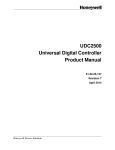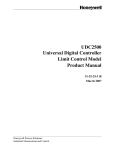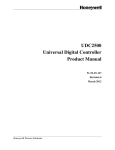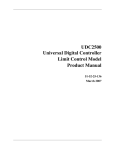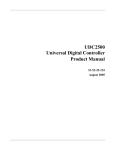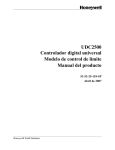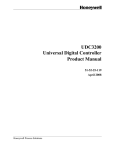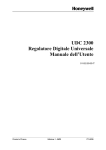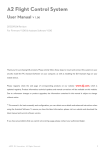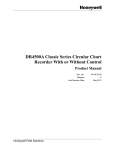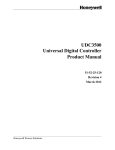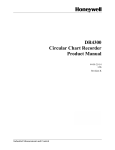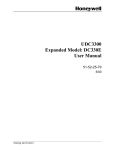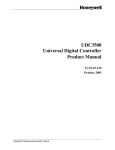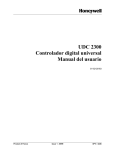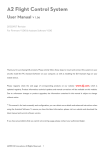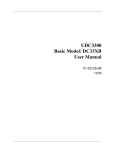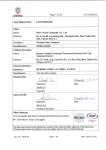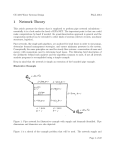Download Honeywell UDC2300 PDF - Lesman Instrument Company
Transcript
UDC 2300 Universal Digital Controller User Manual 51-52-25-83D 4/00 Sensing and Control Notices and Trademarks Copyright 2000 by Honeywell Release D April, 2000 Warranty/Remedy Honeywell warrants goods of its manufacture as being free of defective materials and faulty workmanship. Contact your local sales office for warranty information. If warranted goods are returned to Honeywell during the period of coverage, Honeywell will repair or replace without charge those items it finds defective. The foregoing is Buyer’s sole remedy and is in lieu of all other warranties, expressed or implied, including those of merchantability and fitness for a particular purpose. Specifications may change without notice. The information we supply is believed to be accurate and reliable as of this printing. However, we assume no responsibility for its use. While we provide application assistance personally, through our literature and the Honeywell web site, it is up to the customer to determine the suitability of the product in the application. Sensing and Control Honeywell 11 West Spring Street Freeport, IL 61032 UDC2300 is a U.S. registered trademark of Honeywell Other brand or product names are trademarks of their respective owners. ii UDC2300 Universal Digital Controller User Manual 4/00 About This Document Abstract This document provides descriptions and procedures for the Installation, Configuration, Operation, and Troubleshooting of your UDC2300 Controller. For a full UDC2300 product manual, request document number 51-52-25-73. Contacts World Wide Web The following lists Honeywell’s World Wide Web sites that will be of interest to our customers. Honeywell Organization WWW Address (URL) Corporate http://www.honeywell.com Sensing and Control http://www.honeywell.com/sensing International http://www.honeywell.com/Business/global.asp Telephone Contact us by telephone at the numbers listed below. Organization United States and Canada Honeywell Phone Number 1-800-423-9883 1-888-423-9883 1-800-525-7439 Asia Pacific Honeywell Asia Pacific Hong Kong (852) 2829-8298 Europe Honeywell PACE, Brussels, Belgium [32-2] 728-2111 Latin America Honeywell, Sunrise, Florida U.S.A. (954) 845-2600 4/00 UDC2300 Universal Digital Controller User Manual Tech. Support Q&A Faxback (TACFACS) Service iii Symbol Definitions The following table lists those symbols used in this document to denote certain conditions. Symbol Definition This CAUTION symbol on the equipment refers the user to the Product Manual for additional information. This symbol appears next to required information in the manual. WARNING PERSONAL INJURY: Risk of electrical shock. This symbol warns the user of a potential shock hazard where HAZARDOUS LIVE voltages greater than 30 Vrms, 42.4 Vpeak, or 60 VDC may be accessible. Failure to comply with these instructions could result in death or serious injury. ATTENTION, Electrostatic Discharge (ESD) hazards. Observe precautions for handling electrostatic sensitive devices Protective Earth (PE) terminal. Provided for connection of the protective earth (green or green/yellow) supply system conductor. Functional earth terminal. Used for non-safety purposes such as noise immunity improvement. NOTE: This connection shall be bonded to protective earth at the source of supply in accordance with national local electrical code requirements. Earth Ground. Functional earth connection. NOTE: This connection shall be bonded to Protective earth at the source of supply in accordance with national and local electrical code requirements. Chassis Ground. Identifies a connection to the chassis or frame of the equipment shall be bonded to Protective Earth at the source of supply in accordance with national and local electrical code requirements. iv UDC2300 Universal Digital Controller User Manual 4/00 Contents 1 INTRODUCTION ................................................................................................... 1 1.1 Overview........................................................................................................................ 1 1.2 CE Conformity (Europe)................................................................................................. 2 2 INSTALLATION..................................................................................................... 3 2.1 Overview........................................................................................................................ 3 2.2 Preliminary Checks ........................................................................................................ 3 2.3 Control and Alarm Relay Contact Information ................................................................ 6 2.4 Mounting ........................................................................................................................ 7 2.5 Wiring ............................................................................................................................ 9 2.6 Wiring the Controller .................................................................................................... 11 2.7 Initial Start-up............................................................................................................... 17 2.8 Operator Interface and Key Functions ......................................................................... 18 3 CONFIGURATION .............................................................................................. 19 3.1 Overview...................................................................................................................... 19 3.2 Configuration Procedure .............................................................................................. 19 3.3 Timer Set Up Group..................................................................................................... 22 3.4 Tuning Set Up Group ................................................................................................... 23 3.5 SP Ramp Set Up Group............................................................................................... 25 3.6 Accutune Set Up Group ............................................................................................... 27 3.7 Algorithm Set Up Group............................................................................................... 28 3.8 Input 1 Set Up Group ................................................................................................... 29 3.9 Input 2 Set Up Group ................................................................................................... 31 3.10 Control Set Up Group .................................................................................................. 32 3.11 Options Set Up Group.................................................................................................. 34 3.12 Communications Set Up Group ................................................................................... 35 3.13 Alarms Set Up Group................................................................................................... 37 4 OPERATION ....................................................................................................... 39 4.1 Powering Up the Controller .......................................................................................... 39 4.2 Monitoring Your Controller ........................................................................................... 39 4.3 Single Display Functionality ......................................................................................... 42 4.4 Start Up Procedure for Operation ................................................................................ 44 4/00 UDC2300 Universal Digital Controller User Manual v 4.5 Setpoints...................................................................................................................... 45 4.6 Timer ........................................................................................................................... 46 4.7 Accutune II................................................................................................................... 47 4.8 Fuzzy Overshoot Suppression ..................................................................................... 47 4.9 Using Two Sets of Tuning Constants........................................................................... 48 4.10 Alarms ......................................................................................................................... 49 4.11 Three Position Step Control Algorithm ......................................................................... 50 4.12 Setting a Failsafe Output Value for Restart After a Power Loss................................... 51 4.13 Setting Failsafe Mode .................................................................................................. 52 4.14 Entering a Security Code ............................................................................................. 53 4.15 Lockout Feature........................................................................................................... 54 4.16 Background Tests........................................................................................................ 55 4.17 Restore Factory Calibration ......................................................................................... 57 5 SETPOINT RATE/RAMP/PROGRAM OPERATION ........................................... 59 5.1 Setpoint Rate ............................................................................................................... 59 5.2 Setpoint Ramp ............................................................................................................. 59 5.3 Setpoint Ramp/Soak Programming.............................................................................. 61 6 APPENDIX A - ENVIRONMENTAL AND OPERATING CONDITIONS .............. 67 7 APPENDIX B - MODEL SELECTION GUIDE ..................................................... 69 8 APPENDIX C - CONFIGURATION RECORD SHEET ........................................ 71 vi UDC2300 Universal Digital Controller User Manual 4/00 Tables Table 2-1 Preliminary Checks __________________________________________________ 3 Table 2-2 Control Relay Contact Information ______________________________________ 6 Table 2-3 Alarm Relay Contact Information _______________________________________ 6 Table 2-4 Mounting Procedure _________________________________________________ 8 Table 2-5 Permissible Wiring Bundling __________________________________________ 10 Table 2-6 Universal Output Functionality and Restrictions ___________________________ 10 Table 3-1 Configuration Procedure _____________________________________________ 21 Table 3-2 TIMER Group (Numeric Code 100) Function Prompts ______________________ 22 Table 3-3 TUNING Group (Numeric Code 200) Function Prompts _____________________ 23 Table 3-4 SPRAMP Group (Numeric Code 300) Function Prompts ____________________ 25 Table 3-5 ATUNE Group (Numeric Code 400) Function Prompts______________________ 27 Table 3-6 ALGOR Group (Numeric Code 500) Function Prompts _____________________ 28 Table 3-7 INPUT1 Group (Numeric Code 600) Function Prompts _____________________ 29 Table 3-8 INPUT2 Group (Numeric Code 700) Function Prompts _____________________ 31 Table 3-9 CONTRL Group (Numeric Code 800) Function Prompts ____________________ 32 Table 3-10 Options Group (Numeric Code 900) Function Prompts ____________________ 34 Table 3-11 Communications Group (Numeric Code 1000) ___________________________ 35 Table 3-12 ALARMS Group (Numeric Code 1100) Function Prompts __________________ 37 Table 4-1 Annunciators ______________________________________________________ 39 Table 4-2 Lower Display Key Parameter Prompts__________________________________ 40 Table 4-3 Error Messages ____________________________________________________ 41 Table 4-4 Single Display Parameters ___________________________________________ 43 Table 4-5 Procedure for Starting Up the Controller _________________________________ 44 Table 4-6 Procedure for Switching Between Setpoints ______________________________ 45 Table 4-7 Set Up Procedure __________________________________________________ 48 Table 4-8 Procedure for Switching PID SETS from the Keyboard _____________________ 48 Table 4-9 Procedure for Displaying Alarm Setpoints________________________________ 49 Table 4-10 Procedure for Displaying 3Pstep Motor Position __________________________ 50 Table 4-11 Procedure for Setting a Failsafe Value _________________________________ 51 Table 4-12 Procedure for Setting a Failsafe Mode _________________________________ 52 Table 4-13 Procedure to Enter a Security Code ___________________________________ 53 Table 4-14 Background Tests _________________________________________________ 55 Table 4-15 Restore Factory Calibration__________________________________________ 57 Table 5-1 Running A Setpoint Ramp ____________________________________________ 60 Table 5-2 Program Contents __________________________________________________ 62 Table 5-3 Run/Monitor Functions ______________________________________________ 66 4/00 UDC2300 Universal Digital Controller User Manual vii Figures Figure 1-1 UDC2300 Operator Interface __________________________________________ 1 Figure 2-1 Jumper Placements _________________________________________________ 5 Figure 2-2 Mounting Dimensions (not to scale) _____________________________________ 7 Figure 2-3 Mounting Method ___________________________________________________ 8 Figure 2-4 Composite Wiring Diagram __________________________________________ 11 Figure 2-5 Mains Power Supply________________________________________________ 12 Figure 2-6 Input 1 Connections ________________________________________________ 12 Figure 2-7 Input 2 Connections ________________________________________________ 12 Figure 2-8 Electromechanical Relay Output ______________________________________ 13 Figure 2-9 Solid State Relay Output ____________________________________________ 13 Figure 2-10 Open Collector Relay Output ________________________________________ 14 Figure 2-11 Current Output ___________________________________________________ 14 Figure 2-12 External Solid State Relay Option (Internal Open Collector Output) __________ 15 Figure 2-13 Three-Position Step Control Connections ______________________________ 15 Figure 2-14 Alarm and Duplex Output Connections ________________________________ 16 Figure 2-15 External Interface Option Connections ________________________________ 16 Figure 2-16 Transmitter Power for 4-20 mA — 2 wire Transmitter Using Open Collector Alarm 2 Output (Model DC230B-XT-XX-XX-XXXXXXX-XX-X) ________________ 17 Figure 2-17 Transmitter Power for 4-20 mA — 2 Wire Transmitter Using Auxiliary Output (Model DC230B-XX-2X-XX-XXXXXXX-XX-X)_____________________________ 17 Figure 2-18 Operator Interface and Key Functions _________________________________ 18 Figure 3-1 Prompt Hierarchy __________________________________________________ 20 Figure 5-1 Ramp/Soak Profile Example _________________________________________ 64 Figure 5-2 Program Record Sheet _____________________________________________ 65 viii UDC2300 Universal Digital Controller User Manual 4/00 Introduction 1 Introduction 1.1 Overview The UDC 2300 is a microprocessor-based stand-alone controller. It combines reliability and operating simplicity in a cost-effective 1/4-DIN size controller. The UDC 2300 monitors and controls temperatures and other variables in applications such as environmental chambers, plastic processing machines, furnaces and ovens, and packaging machinery. Its features include: • Universal AC Power Supply, • Input/Output Isolation, • Isolated Auxiliary Current Output / Digital Input, • Modbus and ASCII Communications, • Timer, • Accutune II Tuning with Fuzzy Logic Overshoot Suppression, nd • 2 Input (Remote Setpoint), • Setpoint Ramp/Rate/Program, • Three Position Step Control, • Duplex (Heat/Cool). The UDC 2300 is also downward compatible with existing UDC 2000 applications and installations except for RTD and 0-10 Volt inputs. See wiring diagrams in Section 2 - Installation. ALM 1 2 OUT 1 2 2300 SP 2300 FUNCTION AUTO TUNE DISPLAY MAN-AUTO RESET F C M A R L PV SET UP RUN HOLD Figure 1-1 UDC2300 Operator Interface 4/00 UDC2300 Universal Digital Controller User Manual 1 Introduction 1.2 CE Conformity (Europe) This product is in conformity with the protection requirements of the following European Council Directives: 73/23/EEC, the Low Voltage Directive, and 89/336/EEC, the EMC Directive. Conformity of this product with any other “CE Mark” Directive(s) shall not be assumed. Product Classification: Class I: Permanently connected, panel-mounted Industrial Control Equipment with protective earthing (grounding). (EN61010-1). Enclosure Rating: Panel-mounted equipment, IP 00. This controller must be panel-mounted. Terminals must be enclosed within the panel. Front panel IP 65 (IEC 529). Installation Category (Overvoltage Category): Category II: Energy-consuming equipment supplied from the fixed installation, local level appliances, and Industrial Control Equipment. (EN61010-1) Pollution Degree: Pollution Degree 2: Normally non-conductive pollution with occasional conductivity caused by condensation. (Ref. IEC 664-1) EMC Classification: Group 1, Class A, ISM Equipment (EN55011, emissions), Industrial Equipment (EN50082-2, immunity) Method of EMC Assessment: Technical File (TF) Declaration of Conformity: 51309602-000 Deviation from the installation conditions specified in this manual, and the special conditions for CE conformity in Section 2.1, may invalidate this product’s conformity with the Low Voltage and EMC Directives. 2 UDC2300 Universal Digital Controller User Manual 4/00 Installation 2 Installation 2.1 Overview Introduction Installation of the UDC 2300 consists of mounting and wiring the controller according to the instructions given in this section. Read the pre-installation information, check the model number interpretation (Appendix B), and become familiar with your model selections, then proceed with installation. 2.2 Preliminary Checks Introduction Before you install the controller, remove the chassis and make any preliminary checks necessary that are listed in Table 2-1. Figure 2-1 shows the locations for jumper placements. Table 2-1 Preliminary Checks Check Number Preliminary Check Description 1 Input I Jumper Placement Check the internal jumper for INPUT 1 to make sure it is set for the correct input type. The jumper is located at position S101 on the printed wiring board. Figure 2-1 shows the location of the jumper and position selections. 2 Optional Input 2 (RSP) Jumper Placement Check the internal jumper for INPUT 2 to make sure it is set for the correct input type. The jumper is located at position S201 on the printed wiring board. Figure 2-1 shows the location of the jumper and position selections. 3 Control Relay 1 and Current Output Check the internal jumper (W101) for CONTROL. The relay is shipped as N.O. (Normally Open). Figure 2-1 shows the location of the jumper and position selections. See Table 2-2 for Control Relay contact information. 4/00 UDC2300 Universal Digital Controller User Manual 3 Installation Check Number 4 Preliminary Check Control Relay 2 and Alarm Relay Action. Description The controller has been shipped with ALARM relays configured for N.C. (Normally Closed). If you want to change to N.O. refer to Figure 2-1, Jumper positions W201 and W202: W201 is the ALARM RELAY 1 jumper. W202 is the jumper for CONTROL RELAY #2 for Duplex Output or 3 position step control and an ALARM RELAY 2 for all others. See Table 2-2 for Control Relay contact information, and Table 2-3 for Alarm Relay contact information. See Alarm Relay Caution Note, Page 6. Note: Solid State and open collector Outputs must have jumper set to N.O. (Normally Open). 3 Position Step and Time Duplex must have Output 2-jumper (W202) set to N.O (Normally Open). 4 UDC2300 Universal Digital Controller User Manual 4/00 Installation Jumper Placements Input #2 Jumper 2 1 Position 2 Volt S201 2 Jumper Position 1 mA 1 Note: Jumpers enlarged for clarity 2 1 S201 W201 NO NC W202 NO Alarm Relay #1 W201 NO NC Main Board NC (default) NC S101 4 3 2 1 NO NO W101 NO NC NC Output #2/ Alarm Relay #2 W202 NO NC (default) Input #1 NC 4 NO 3 2 S101 1 NO Position 1: thermocouple (default) NC Position 2: mV, Volt, RTD Output #1 W101 Position 3: not used NO NC Position 4:mA NC NO NC NO (Default) No jumper: 0 -10 volts 1 1. For Current Output use the N.O. position Figure 2-1 Jumper Placements 4/00 UDC2300 Universal Digital Controller User Manual 5 Installation 2.3 Control and Alarm Relay Contact Information Control Relays ATTENTION Control relays operate in the standard control mode (that is, energized when output state is on). Table 2-2 Control Relay Contact Information Unit Power Control Relay Wiring Off On Control Relay Contact #1 or #2 Output Indicator Status N.O. Open N.C. Closed N.O. Open Closed Off On N.C. Closed Open Off On Off Alarm Relays ATTENTION Alarm relays are designed to operate in a Failsafe mode (that is, de-energized during alarm sate). This results in alarm actuation when power is OFF or when initially applied, until the unit completes self-diagnostics. If power is lost to the unit, the alarms will function. Table 2-3 Alarm Relay Contact Information Unit Power Off On 6 Alarm Relay Wiring Variable NOT in Alarm State Variable in Alarm State Relay Contact Relay Contact N.O. Open N.C. Closed N.O. Closed N.C. Open Indicators Off Open Indicators Off Closed Off Open On Closed UDC2300 Universal Digital Controller User Manual 4/00 Installation 2.4 Mounting Physical Considerations The controller can be mounted on either a vertical or tilted panel using the mounting kit supplied. Adequate access space must be available at the back of the panel for installation and servicing activities. • The controller’s mounting enclosure must be grounded according to CSA standard C22.2 No. 0.4 or Factory Mutual Class No. 3820 paragraph 6.1.5. • The front panel is moisture rated NEMA 3/IP65 (IEC) when properly installed with panel gasket. Overall Dimensions +0.8 +0.008 90 92 =0.0 -0.0 +0.03 3.5906 3.622 +0.031 -0.0 96 3.780 92 3.622 96 Panel Cutout 3.780 24 Max Panel Thickness .945 10 Max (2) .394 2.62 .103 +0.008 -0.0 +0.031 -0.0 with optional rear cover 90.7 3.57 Dimensions: Millimeters 21.0 .826 105.4 4.19 Inches 20751 Figure 2-2 Mounting Dimensions (not to scale) 4/00 UDC2300 Universal Digital Controller User Manual 7 Installation Mounting Method Before mounting the controller, refer to the nameplate on the outside of the case and make a note of the model number. It will help later when selecting the proper wiring configuration. Panel 20752 Figure 2-3 Mounting Method Mounting Procedure Table 2-4 Mounting Procedure Step 8 Action 1 Mark and cut out the controller hole in the panel according to the dimension information in Figure 2-2. 2 Remove the screw cover and loosen the screw on the front of the controller. Pull the chassis out of the case. 3 Orient the case properly and slide it through the panel hole from the front. 4 Remove the mounting kit from the shipping container and install the kit as follows: • Install the screws into the threaded holes of the clips. • Insert the prongs of the clips into the two holes in the top and bottom of the case. • Tighten both screws to secure the case against the panel. • Carefully slide the chassis assembly into the case, press to close, and tighten the screw. Replace the screw cover. UDC2300 Universal Digital Controller User Manual 4/00 Installation 2.5 Wiring Electrical Considerations he controller is considered “rack and panel mounted equipment” per EN61010-1, afety Requirements for Electrical Equipment for Measurement, Control, and aboratory Use, Part 1: General Requirements. Conformity with 72/23/EEC, the ow Voltage Directive requires the user to provide adequate protection against a hock hazard. The user shall install this controller in an enclosure that limits PERATOR access to the rear terminals. Mains Power Supply This equipment is suitable for connection to 90 to 264 Vac, 50/60 Hz, power supply mains. It is the user’s responsibility to provide a switch and non-time delay (North America), quick-acting, high breaking capacity, Type F (Europe), 1/2A, 250V fuse(s), or circuit-breaker, as part of the installation. The switch or circuit breaker shall be located in close proximity to the controller, within easy reach of the OPERATOR. The switch or circuit breaker shall be marked as the disconnecting device for the controller. Controller Grounding PROTECTIVE BONDING (grounding) of this controller and the enclosure in which it is installed shall be in accordance with National and Local electrical codes. To minimize electrical noise and transients that may adversely affect the system, supplementary bonding of the controller enclosure to a local ground, using a No. 12 (4 mm2) copper conductor, is recommended. Control/Alarm Circuit Wiring The insulation of wires connected to the Control/Alarm terminals shall be rated for the highest voltage involved. Extra Low Voltage (ELV) wiring (input, current output, and low voltage Control/Alarm circuits) shall be separated from HAZARDOUS LIVE (>30 Vac, 42.4 Vpeak, or 60 Vdc) wiring per Permissible Wiring Bundling, Table 2-5. Electrical Noise Precautions Electrical noise is composed of unabated electrical signals, which produce undesirable effects in measurements and control circuits. Digital equipment is especially sensitive to the effects of electrical noise. Your controller has built-in circuits to reduce the effect of electrical noise from various sources. If there is a need to further reduce these effects: • 4/00 Separate External Wiring—Separate connecting wires into bundles (See Permissible Wiring Bundling - Table 2-5) and route the individual bundles through separate conduit metal trays. UDC2300 Universal Digital Controller User Manual 9 Installation • Use Suppression Devices—For additional noise protection, you may want to add suppression devices at the external source. Appropriate suppression devices are commercially available. ATTENTION For additional noise information, refer to Document #51-52-05-01, How to Apply Digital Instrumentation in Severe Electrical Noise Environments. Permissible Wiring Bundling Table 2-5 Permissible Wiring Bundling Bundle No. 1 2 3 Wire Functions • Line power wiring • Earth ground wiring • Control relay output wiring • Line voltage alarm wiring Analog signal wire, such as: • Input signal wire (thermocouple, 4 to 20 mA, etc.) • 4-20 mA output signal wiring Digital input signals • Low voltage alarm relay output wiring • Low voltage wiring to solid state type control circuits Universal Output Functionality and Restrictions Table 2-6 Universal Output Functionality and Restrictions Output Type Time Simplex 1 Time Simplex 2 Current Simplex Time Duplex or TPSC Current Dup. 100 % Current Dup. 50 % Current/Time Timer/Current Current Output N/I N/A Output N/I Relay #1 Output/Socket Relay #2 Relay #3 Output 1 N/I N/I Output 1 Alarm 2 Output 1 Alarm 2 Output 2 Alarm 1 Alarm 1 Alarm 1 Alarm 1 Not Needed Not Needed Not Needed Not Needed Output 1 Output 1 Output 1 Output 2 N/I N/I N/I N/I Alarm 2 Alarm 2 Output 2 Output 1 Alarm 1 Alarm 1 Alarm 1 Alarm 1 Not Needed Output 2 Not Needed Not Needed Auxiliary Output N/I = Not Installed N/A = The output form or the individual output is Not Available or is not used for this output form. Not Needed = Auxiliary Output is not needed to provide the desired output function and can be used for another purpose. Auxiliary Output could also be used as a substitute for current Output 1. 10 UDC2300 Universal Digital Controller User Manual 4/00 Installation 2.6 Wiring the Controller Using the information contained in the model number, select the appropriate wiring diagrams from the composite wiring diagram below. Refer to the individual diagrams listed to wire the controller according to your requirements. Composite Wiring Diagram Mains Power Supply Input 1 Connections Input 2 Connections Relay Output Electromechanical Solid State Open Collector Current Output Connections External Solid State Relay Output Option Three Position Step Control Connections Alarm and Duplex Output Connections External Interface Option Connections Transmitter Power for 4-20mA – 2-Wire Transmitter Using Open Collector Alarm 2 Output Transmitter Power for 4-20mA – 2-Wire Transmitter Using Auxiliary Output Transmitter Power for 4-20 mA 2-wire transmitters • Using Alarm Output See Figure 2-16 • Using Aux Output See Figure 2-17 Input Terminal See Figure 2-6 Control Output Terminals See Note 1 Mains Power Supply Terminals See Figure 2-5 8 7 6 5 4 L2 / N L1 9 10 11 12 13 14 15 16 11 12 12 12 13 13 14 14 15 15 16 16 17 17 Alarm and Duplex Output Connections See Figure 2-14 External Interface Options Terminals See Figure 2-15 Input #2 Terminals See Figure 2-7 NOTE1: Time Proportional Electromechanical Relay Output – See Figure 2-8 Time Proportional Solid State Relay Output – See Figure 2-9 Time Proportional Open Collector Output – See Figure 2-10 Current Output – See Figure 2-11 External Solid State Relay Output – See Figure 2-12 Three Position Step Control Output – See Figure 2-13 24855 Figure 2-4 Composite Wiring Diagram 4/00 UDC2300 Universal Digital Controller User Manual 11 Installation Mains power supply Neutral 2 Hot L2 / N L1 Ground 1 24856 1 PROTECTIVE BONDING (grounding) of this controller and the enclosure in which it is installed, shall be in accordance with National and Local electrical codes. To minimize electrical noise and transients that may adversely affect the system, supplementary bonding of the controller enclosure to a local ground, using a No. 12 (4 mm2) copper conductor, is recommended. Before powering the controller, see “Preliminary Checks” in this section of the user manual for switch and jumper settings. 2 Provide a switch and non-time delay (North America), quick-acting, high breaking capacity, type F (Europe), 1/2 A, 250 V fuse(s), or circuit-breaker as part of the installation. Figure 2-5 Mains Power Supply Thermocouple RTD 8+ Use Thermocouple extension wire only mV, Volts (except 0-10V), Milliamperes, orRadiamatic 1 8+ 76 R Platinum RTD mV, Volt, or 7Milliampere Source 6R 8+ 76R 0 to 10 Volts Volt Source + 1 _ 3 8+ 7 _ 6R 2 The voltage divider for 0 to 10 Volts is supplied with the controller when the input is specified. You must install it when you wire the controller before start-up. 1 24857 1 These inputs are wired differently than the UDC2000 Figure 2-6 Input 1 Connections 15 16 + _ 0 to 20 mA, 4 to 20 mA, 0 to 5 Volts 1 to 5 Volts See “Preliminary Checks” in this section of the User Manual for jumper selections. 24858 Figure 2-7 Input 2 Connections 12 UDC2300 Universal Digital Controller User Manual 4/00 Installation 1 Load Supply Power Control Relay #1 Load OUT1 5 OUT2/ALM2 9 4 10 5 amp Fast Blo 24859 1 Control relays 1 and 2 are configured N.O. as shipped. Alarm relays 1 and 2 are configured N.C. as shipped. N.O. or N.C. configurations are selectable by jumpers on the Main printed wiring boards. See “Preliminary Checks” in this section of the User Manual for details. Each SPST relay is rated at 5A, 120 Vac and 30 Vdc, 2.5 A 240 Vac. User-provided fuses should be sized accordingly. For solid state relay outputs, see Figure 2-12. See Figure 2-14 for Alarm and Duplex Output Connections. See Table 2-2 and Table 2-3 for Control and Alarm Relay Contact information. Figure 2-8 Electromechanical Relay Output AC Load Power Supply 2 1 amp Fast Blo Control Relay #1 Load OUT1 OUT2/ALM2 5 4 Dummy Resistor 1 9 10 24860 1 If the load current is less than the minimum rated value of 20 mA, there may be a residual voltage across both ends of the load even if the relay is turned off. Use a dummy resistor as shown to counteract this. The total current through the resistor and the load current must exceed 20 mA. 2 Solid State relay is rated at 1 Amp at 25°C, linearly derated to 0.5 Amp at 55°C. Customer should size fuse accordingly. See Figure 2-14 for Alarm and Duplex Output Connections. See Table 2-2 and Table 2-3 for Control and Alarm Relay Contact information. Figure 2-9 Solid State Relay Output 4/00 UDC2300 Universal Digital Controller User Manual 13 Installation Customer Supplied External Solid State Relay Customer Supplied External Electromechanical Relay 0-24 Vdc 1 1 – OUT1 OUT2/ALM2 – + 1 CAUTION 9– 10+ 5– 4+ + OUT1 OUT2/ALM2 5– 4+ 9– 10+ 0-24 Vdc 24861M Open collector outputs are internally powered at 24 Vdc. Connecting an external supply will damage the controller. External relays should be fused between power and relay load. See Figure 2-14 for Alarm and Duplex Output Connections. See Tables 2-2 and 2-3 for Control and Alarm Relay Contact information. Figure 2-10 Open Collector Relay Output 2 1 + Controller Load 0 to 750 Ohms Current output 4 to 20 mA 24862 5 4 1 CAUTION Installing a current output instrument into a case wired for relay outputs will damage the instrument. 2 Connect shield to ground at one end only. 3 Set output jumper per Figure 2-2. See Figure 2-14 for Alarm and Duplex Output Connections. See Table 2-2 and Table 2-3 for Control and Alarm Relay Contact information. Figure 2-11 Current Output 14 UDC2300 Universal Digital Controller User Manual 4/00 Installation 10 amp Fast Blo L1/H 10 Amp Solid State Relay Assembly 1 L2/N LOAD OUTPUT1 OUTPUT2 White Black Green 54+ L2 / N L1 910+ L2 / N L1 AC + - Green Black White Relay Assembly 24863M 1 This Solid State relay is rated at 15 Amps at 25°C, linearly derated to 10 Amps at 55°C. Customer should size fuse accordingly Figure 2-12 External Solid State Relay Option (Internal Open Collector Output) Close (CCW) Open (CW) 9 10 Motor Power Supply 2 amp Fast Blo 5+ 4- 1 1 Control Relay #2 Control Relay #1 24864M Alarm #2 is not available with Three Position Step Control. See Figure 2-14 for Alarm and Duplex Output connections. Figure 2-13 Three-Position Step Control Connections 4/00 UDC2300 Universal Digital Controller User Manual 15 Installation 1 2 Control or Alarm Relay #2 Load Load 5 amp Fast Blo Supply Power 1 Alarm Load Relay #1 Load 5 amp fast Blo Supply Power 9 10 11 12 24867 1 Control relays 1 and 2 are configured N.O. as shipped. Alarm relays 1 and 2 are configured N.C. as shipped. N.O. or N.C. configurations are selectable by jumpers on main printed wiring boards. See “Preliminar Checks” in this sections of the User Manual for details. Each SPST relay is rated at 5 A, 120 Vac and 30 Vdc, 2.5 A, 240 Vac. 2 Alarm #2 not available for Time Proportional Duplex or Three Position Step Control. Figure 2-14 Alarm and Duplex Output Connections 1 Digital Inputs 1 Auxiliary Output 13 14 + _ Auxiliary Load 0 - 500 Ω + _ 13 14 Contact Input Switch Connect shield to ground at one end only. Connect shield to ground at one end only. Communications 1 COMMUNICATION MASTER (A) D+ (RTN) (B) SHLD D– 2 13 D+ 14 D– 120 OHMS 1 TO OTHER COMMUNICATION CONTROLLERS D– 1 2 Connect shield wires together with Honeywell supplied crimp part number 30755381-001 Do not run these lines in the same conduit as AC power. D+ 120 OHMS ON LAST LEG 21758B.ppt 1 AuxOut , Digital Input and Communications are mutually exclusive. Figure 2-15 External Interface Option Connections 16 UDC2300 Universal Digital Controller User Manual 4/00 Installation 2 Wire Transmitter _ INPUT 1 8+ 7- OUTPUT 2 9– 10+ + Configure: A2S1TYPE = NONE A2S2TYPE = NONE Figure 2-16 Transmitter Power for 4-20 mA — 2 wire Transmitter Using Open Collector Alarm 2 Output (Model DC230B-XT-XX-XX-XXXXXXX-XX-X) 2 Wire Transmitter _ INPUT 1 8+ 7- + AUXOUT 13 + 14 - Configure: AUXOUT = OUT Auxiliary Output Calibration ZEROVAL = 4095 SPANVAL = 4095 Figure 2-17 Transmitter Power for 4-20 mA — 2 Wire Transmitter Using Auxiliary Output (Model DC230B-XX-2X-XX-XXXXXXX-XX-X) 2.7 Initial Start-up Overview This section gives you the information necessary to start up your controller prior to configuration. Review the Operator Interface portion (Subsection 2.8) to make sure you are familiar with the indicator definitions and key functions. Apply Power When power is applied, the controller will run three diagnostic tests. After these tests are completed, “TEST DONE” is displayed. 4/00 UDC2300 Universal Digital Controller User Manual 17 Installation Test Failures If one or more of these tests fail, the controller will go to the Failsafe Manual Mode, and FAILSF will flash in the lower display and a message indicating which test failed will appear in the lower display. Then, “DONE” will appear in the lower display. 2.8 Operator Interface and Key Functions Upper Display - Four digits • Normal operation - Process Variable • Configuration mode - displays parameter value or selection • TUNE- Accutune in progress ALM - Alarm conditions exist OUT - Control Relay 1 or 2 on ALM 12 OUT 12 2300 SP 2300 FUNCTION Keys DISPLAY MAN-AUTO RESET AUTO TUNE F C M A R L PV SET UP F - °Fahrenheit being used C - °Centigrade being used M or A - Manual/Auto display R - Remote or Local SP2 setpoint active L - Local setpoint active Lower Display - Six alphanumeric characters • Normal operation – display is blank unless configured For default prompt of PV or Setpoint • Configuration mode - displays functions and parameters RUN HOLD 24868 FUNCTION DISPLAY MAN-AUTO RESET SET UP Selects functions within each configuration group. Selects 2nd Setpoint or Remote Setpoint. AUTO TUNE Initiates Limit Cycle Tuning (Accutune). Returns Controller to normal display from Set Up mode. Toggles various operating parameters for display. Increases setpoint or output value. Increases the configuration values or changes functions in Configuration mode groups. Selects Manual or Auto mode. Resets the latching Limit Controller relay. In Set Up mode, used to restore original value or selection. Decreases setpoint or output value. Decreases the configuration values or changes functions in Configuration mode groups. Scrolls through the configuration Setup groups. RUN HOLD Enables Run/Hold of the SP Ramp or Program plus Timer start. Figure 2-18 Operator Interface and Key Functions Key Error Message When a key is pressed and the prompt KEYERR appears in the lower display, it will be for one of the following reasons: • parameter is not available, • not in Set Up mode, press SET UP key first, • key malfunction. 18 UDC2300 Universal Digital Controller User Manual 4/00 Configuration 3 Configuration 3.1 Overview Introduction Configuration is a dedicated operation where you use straightforward keystroke sequences to select and establish (configure) pertinent control data best suited for your application. To assist you in the configuration process, there are prompts that appear in the upper and lower displays. These prompts let you know what group of configuration data (Set Up prompts) you are working with and also, the specific parameters (Function prompts) associated with each group. Figure 3-1 shows you an overview of the prompt hierarchy as they appear in the controller. As you will see, the configuration data is divided into 11 main Set Up groups plus prompts for calibration and prompts that show the status of the continuous background tests that are being performed. 3.2 Configuration Procedure Introduction Each of the Set Up groups and their functions are pre-configured at the factory. The factory settings are shown in Table 3-2 through Table 3-12 that follow this procedure. If you want to change any of these selections or values, follow the procedure in Table 3-1 Configuration Procedure. This procedure tells you the keys to press to get to any Set Up group and any associated Function parameter prompt. Record your selections on the Configuration Record Sheet found in Section 8 – Appendix C. 4/00 UDC2300 Universal Digital Controller User Manual 19 Configuration Figure 3-1 Prompt Hierarchy Set Up Group TIMER TIMER PERIOD START L DISP RESET INCRMT TUNING PB or GAIN RATE T I MIN or I RPM MANRST PB 2 or GAIN 2 RATE2T I2 MIN or I2 RPM CYC2T2 or CT2 X3 SECUR LOCK AUTOMA A TUNE RN HLD SP SL SPRAMP TI MIN FINLSP SPRATE EUHRUP EUHRDN SPPROG STRSEG ENDSEG RPUNIT RECYCL SOKDEV PG END STATE ToBEGN PVSTRT SGx RP* SGxSP* SGx TI* * x = 1 to 12. Program concludes after segment 12 ATUNE FUZZY TUNE AT ERR ALGOR CTRALG OUTALG 4-20RG RLY TYP INPUT1 DECMAL UNITS IN1TYP XMITR1 IN1 HI IN1 LO FILTR1 BRNOUT EMISS FREQ DISPLY LNGUAG INPUT2 IN2TYP XMITR2 IN2 HI IN2 LO RATIO2 BIAS 2 FILTR2 CONTRL PIDSET SW VAL LSP’S RSP SRC SP TRK PWR UP PWROUT SP Hi SP Lo ACTION OUT Hi OUT Lo D BAND HYST FAILSF FSMODE PBorGN MINRPM OPTIONS AUXOUT 0 PCT 100 PCT DIG IN DI COM COM ComSTA ComADD SDENAB SHDTIM PARITY BAUD WS_FLT TXDLY SDMODE SHD_SP UNITS CSRATO CSP_BI LOOPBK A1S1VA A1S2VA A2S1VA A2S2VA A1S1TY A1S2TY A2S1TY A2S2TY A1S1HL A1S1EV A1S2HL A1S2EV A2S1HL A2S1EV A2S2HL A2S2EV ALHYST ALARM1 BLOCK VERSON FAILSF TESTS SPRAMP ALARMS STATUS 20 Function Prompts UDC2300 Universal Digital Controller User Manual RATIO1 CYC T1 or CT1 X3 BIAS 1 4/00 Configuration Procedure ATTENTION The prompting scrolls at a rate of 2/3 seconds when the SET UP or FUNCTION key is held in. Also, [▲] [▼] keys will move group prompts forward or backward at a rate twice as fast. Table 3-1 Configuration Procedure Step 1 2 Operation Press Enter Set Up Mode SET UP Select any Set Up Group SET UP Result Upper Display = SET Lower Display = TIMER (This is the first Set Up Group title) Sequentially displays the other Set Up group titles. You can also use the [▲] [▼] keys to scan the Set Up groups in both directions. Stop at the Set Up group title that describes the group of parameters you want to configure. Then proceed to the next step. 3 Select a Function Parameter FUNCTION Upper Display = the current value or selection for the first function prompt of the selected Set Up group. Lower Display = the first Function prompt within that Set Up group. Sequentially displays the other function prompts of the Set Up group you have selected. Stop at the function prompt that you want to change, then proceed to the next step. 4 Change the Value or Selection 5 Enter the Value or Selection 6 Exit Configuration 4/00 [▲] [▼] FUNCTION DISPLAY Increments or decrements the value or selection that appears for the selected function prompt. If you change the value or selection of a parameter while in Set Up mode then decide not to enter it, press [MANAUTO/RESET] once—the original value or selection is recalled. Enters value or selection made into memory after another key is pressed. Exits configuration mode and returns controller to the same state it was in immediately preceding entry into the Set Up mode. It stores any changes you have made. If you do not press any keys for 30 seconds, the controller times out and reverts to the mode and display used prior to entry into Set Up mode. UDC2300 Universal Digital Controller User Manual 21 Configuration 3.3 Timer Set Up Group Introduction The Timer Set Up group allows you to configure a time-out period and to select the timer start by either the keyboard (RUN/HOLD key) or Alarm 2. The optional digital input can also be configured to start the timer. The timer display is selectable as either “time remaining” (see TREM) or “elapsed time” (see ET). Alarm 1 is activated at the end of the time-out period. When the timer is enabled, it has exclusive control of the alarm 1 relay—any previous alarm 1 configuration is ignored. At time-out, the timer is ready to be activated again by whatever action has been configured. Function Prompts Table 3-2 TIMER Group (Numeric Code 100) Function Prompts Prompt English Description Numeric Code Numeric Code TIMER 101 Enable or Disable Timer PERIOD 102 Time-out Period START 103 Timer Function Start L DISP 104 RESET INCRMT 22 Selection or Range of Setting 0 1 English Factory Setting DIS ENAB DIS 0:00 to 99:59 Select length of time in Hours and Minutes, or Minutes and Seconds. 0:01 0 1 KEY (Run/Hold key) AL2 (Alarm 2) KEY Timer Display 0 1 TREM (time remaining) ET (elapsed time) TREM 105 Timer Reset Control 0 1 KEY (Run/Hold key) AL1 (Alarm 1 or Key) KEY 106 Timer Count Increment 0 1 MIN (Counts HR/MIN) MIN SEC (Counts MIN/SEC) UDC2300 Universal Digital Controller User Manual 4/00 Configuration 3.4 Tuning Set Up Group Introduction Tuning consists of establishing the appropriate values for the tuning constants you are using so that your controller responds correctly to changes in process variable and setpoint. You can start with predetermined values but you will have to watch the system to see how to modify them. The Accutune feature automatically selects Gain, Rate, and Reset on demand. ATTENTION Because this group contains functions that have to do with security and lockout, we recommend that you configure this group last, after all other configuration data has been loaded. Function Prompts Table 3-3 TUNING Group (Numeric Code 200) Function Prompts Prompt English Description Numeric Code Selection or Range of Setting Numeric Code English Factory Setting PB or GAIN 201 Proportional Band or Gain PB = 0.1 to 1000 % Gain = 0.01 to 1000 1.0 RATE T 202 Rate in Minutes 0.00 to 10.00 minutes 0.08 or less = OFF 0.00 I MIN or I RPM 203 Reset in minutes/repeat Reset in repeats/minute 0.02 to 50.00 1.0 0.02 to 50.00 1.0 MANRST 204 Manual Reset -100 to 100 % Output 0.0 PB 2 or GAIN 2 205 Proportional Band 2 or Gain 2 PB = 0.1 to 1000 % Gain = 0.01 to 1000 1.0 RATE2T 206 Rate 2 in Minutes 0.00 to 10.00 minutes 0.08 or less = OFF 0.00 I2 MIN or I2 RPM 207 Reset in minutes/repeat Reset in repeats/minute 0.02 to 50.00 1.0 0.02 to 50.00 1.0 Table continued next page 4/00 UDC2300 Universal Digital Controller User Manual 23 Configuration Table 3-3 TUNING Group (Numeric Code 200) Function Prompts, continued Prompt English Description Numeric Code Selection or Range of Setting Numeric Code Factory Setting English CYC T1 or 208 CT1X3 Cycle Time (Heat) Cycle times are in either second or 1/3 second increments depending upon the configuration of RLY TYP in the “Algorithm” Set Up group. 1 to 120 20 CYC2T2 or CT2 X3 209 Cycle Time (Cool) Cycle times are in either second or 1/3 second increments depending upon the configuration of RLY TYP in the “Algorithm” Set Up group. 1 to 120 20 SECUR 210 Security Code 0 to 4095 0 LOCK 211 Lockout 0 1 2 3 4 NONE CAL CONF VIEW ALL CAL AUTOMA 212 Auto/Manual Key Lockout 0 1 DIS ENAB ENAB A TUNE 213 Autotune Key Lockout 0 1 DIS ENAB ENAB RN HLD 214 Run/Hold Key Lockout 0 1 DIS ENAB ENAB SP SEL 215 Setpoint Select Function Lockout 0 1 DIS ENAB ENAB 24 UDC2300 Universal Digital Controller User Manual 4/00 Configuration 3.5 SP Ramp Set Up Group Introduction A single setpoint ramp [SPRAMP] can be configured to occur between the current local setpoint and a final local setpoint over a time interval of from 1 to 255 minutes. SPRATE lets you configure a specific rate of change for any local setpoint change. You can also configure a 12-segment program from a Ramp/Soak profile. You can start and stop the ramp/program using the RUN/HOLD key. PV Hot Start is standard and means that at power up, the setpoint is set to the current PV value and the Ramp or Rate or Program then starts from this value. Function Prompts Table 3-4 SPRAMP Group (Numeric Code 300) Function Prompts Prompt Description English Numeric Code SP RAMP 301 Single Setpoint Ramp Rate and Program must be disabled TI MIN 301 FINLSP Selection or Range of Setting Numeric Code 0 1 English Factory Setting DIS ENAB DIS Single Setpoint Ramp Time 0 to 255 Minutes 3 302 Setpoint Ramp Final Setpoint Enter a value within the setpoint limits 1000 SPRATE 304 Setpoint Rate Ramp and Program must be disabled DIS ENAB DIS EUHRUP 305 Rate Up 0 to 9999 in Engineering units per hour 0 EUHRDN 306 Rate Down 0 to 9999 in Engineering units per hour 0 SPPROG 307 Setpoint Ramp/Soak Programming Rate and Ramp must be disabled DIS ENAB DIS STRSEG 308 Start Segment Number 1 to 11 --- 0 1 0 1 Table continued next page 4/00 UDC2300 Universal Digital Controller User Manual 25 Configuration Prompt English ENDSEG Description Numeric Code 309 Selection or Range of Setting Numeric Code End Segment Number English Factory Setting 2 4 6 8 10 12 2 to 12 (always end in a soak segment 2, 4, …12) SOK 2 SOK4 SOK6 SOK8 SOK10 SOK12 0 0 1 2 TIME (hours:minutes) EU-M (Rate EU/Minute) EU-H (Rate EU/Hour) TIME RPUNIT 310 Engineering units for Ramp Segments RECYCL 311 Number of Program Recycles 0 to 99 recycles --- SOKDEV 312 Guaranteed Soak Deviation Value 0 to 99 0 = No Soak --- PG END 313 Program Termination State 0 1 LAST (Hold at last SP) FSAF (Manual mode/Failsafe) --- STATE 314 Program State at Program End 0 1 DIS HOLD DIS ToBEGN 315 Reset Program to the Beginning 0 1 DIS KEY (Keyboard) DIS PVSTRT 316 Program starts at PV value 0 1 DIS ENAB DIS Segment Ramp or Rate Time x = 1 through 11 0-99hours:0-59minutes Engineering Units/minute or Engineering Units /hour --- Segment Soak Setpoint Value x = 2 through 12 Enter a Value within the Setpoint Limits --- Segment Soak Duration x = 2 through 12 0-99 Hours: 0-59 Minutes - - - SGx RP SG1 SG3 SG5 SG7 SG9 SG11 317 320 323 326 329 332 SGx SP SG2 SG4 SG6 SG8 SG10 SG12 318 321 324 327 330 333 SGx TI SG2 SG4 SG6 SG8 SG10 SG12 26 319 322 325 328 331 334 UDC2300 Universal Digital Controller User Manual 4/00 Configuration 3.6 Accutune Set Up Group Introduction Accutune II automatically calculates GAIN, RATE, and RESET TIME (PID) tuning constants for your control loop. When initiated on demand, the Accutune algorithm measures a process step response and automatically generates the PID tuning constants needed for no overshoot on your process. Fuzzy Overshoot Suppression, when enabled, will suppress or eliminate any overshoot that may occur as a result of the existing tuning parameters, as the PV approaches the setpoint. Function Prompts Table 3-5 ATUNE Group (Numeric Code 400) Function Prompts Prompt English Description Numeric Code Selection or Range of Setting Numeric Code English Factory Setting FUZZY 401 Fuzzy Overshoot Suppression 0 1 DIS ENAB DIS TUNE 402 Demand Tuning 0 1 DIS TUNE TUNE AT ERR 403 Accutune Error Codes (Read Only) 0 3 4 5 NONE IDFL ABRT RUN --- 4/00 UDC2300 Universal Digital Controller User Manual 27 Configuration 3.7 Algorithm Set Up Group Introduction This data deals with various algorithms in the controller: Control algorithm, Output algorithm, Current Duplex Range, and Relay Cycle Time Increment. Function Prompts Table 3-6 ALGOR Group (Numeric Code 500) Function Prompts Prompt English Description Numeric Code Selection or Range of Setting Numeric Code English Factory Setting CTRALG 501 Control Algorithm 0 1 2 3 4 ONOF PIDA PIDB PDMR TPSC (3 position step) PIDA OUTALG 502 Output Algorithm 0 1 2 3 4 5 6 7 RLY (Time simplex Relay 1) RLY2 (Time simplex Relay 2) CUR (Current simplex) TPSC (3 Position step) RLYD (Time duplex) CURD (Current duplex) CURT (Current/time duplex) TCUR (Time/current duplex) depends on model 4-20RG 503 Current Duplex Range 0 1 100 (Full) 50 (Split) 100 RLY TYP 504 Relay Cycle Time Increment 0 MECH (one sec. increments) S S (1/3 sec increments) MECH 1 28 UDC2300 Universal Digital Controller User Manual 4/00 Configuration 3.8 Input 1 Set Up Group Function Prompts Table 3-7 INPUT1 Group (Numeric Code 600) Function Prompts Prompt Description Selection or Range of Setting English Numeric Code Numeric Code English DECMAL 601 Decimal Point Selection 0 1 2 8888 (none) 888.8 88.88 UNITS 602 Temperature Units 1 2 0 F C NONE Factory Setting 8888 F Numeric English Numeric English IN1TYP 603 Input 1 Actuation Type 1 2 3 4 5 6 7 8 9 10 11 12 13 14 15 16 B EH EL JH JL KH KL NNMH NNML N90H N90L NIC R S TH TL 17 18 19 20 21 22 23 24 25 26 27 28 29 30 31 33 WH WL 100H 100L 200 500 RADH RADI 0-20 4-20 10m 50m 0-5 1-5 0-10 100m KH Numeric English Numeric English XMITR1 4/00 604 Transmitter Characterization 0 1 2 3 4 5 6 7 8 9 10 11 12 B EH EL JH JL KH KL NNMH NNML N90H N90L NIC R 13 14 15 16 17 18 19 20 21 22 23 24 25 UDC2300 Universal Digital Controller User Manual S TH TL WH WL 100H 100L 200 500 RADH RADI LIN SrT LIN 29 Configuration Table 3-7 INPUT1 Group (Numeric Code 600) Function Prompts, continued Prompt English Description Numeric Code Selection or Range of Setting Numeric Code English Factory Setting IN1 HI 605 Input 1 High Range Value −999 to 9999 floating in engineering units 2400 IN1 LO 606 Input 1 Low Range Value −999 to 9999 floating in engineering units 0 RATIO1 607 Ratio on Input 1 -20.0 to 20.0 BIAS 1 608 Bias on Input 1 -999 to 9999 0.0 FILTR1 609 Filter for Input 1 0 to 120 seconds 0 = No Filter 1.0 BRNOUT 610 Burnout Protection (Sensor Break) NONE UP (Upscale) DOWN (Downscale) NOFS (No Failsafe) UP EMISS 611 Emissivity 0.01 to 1.00 (RADH & RADI only) 1.0 FREQ 612 Power Line Frequency 0 1 60 50 60 DISPLY 613 Default Display (Single Display models only) 0 1 2 SP (Setpoint) PRY ( PV with Label) PRN (PV without Label) LNGUAG 614 Language Selection 0 1 2 3 4 5 ENGL FREN GERM SPAN ITAL NUMB (Numeric) 30 0 1 2 3 UDC2300 Universal Digital Controller User Manual 1.00 PRN ENGL 4/00 Configuration 3.9 Input 2 Set Up Group Function Prompts Table 3-8 INPUT2 Group (Numeric Code 700) Function Prompts Prompt English IN2TYP Description Numeric Code 701 Selection or Range of Setting Numeric Code Input 2 Type 0 25 26 29 30 34 English DIS 0-20 (mA) 4-20 (mA) 0-5 (Volts) 1-5 (Volts) 0-2 (Volts) Factory Setting 1-5V Numeric English Numeric English XMITR2 702 Transmitter Characterization for Input 2 0 1 2 3 4 5 6 7 8 9 10 11 12 Numeric Code B EH EL JH JL KH KL NNMH NNML N90H N90L NIC R 13 14 15 16 17 18 19 20 21 22 23 24 25 S TH TL WH WL 100H 100L 200 500 RADH RADI LIN SrT LIN English IN2 HI 703 Input 2 High Range Value −999 to 9999 floating in engineering units 2400 IN2 LO 704 Input 2 Low Range Value −999 to 9999 floating in engineering units 0 RATIO2 705 Ratio on Input 2 -20.0 to 20.0 BIAS 2 706 Bias on Input 2 -999 to 9999 0.0 FILTR2 707 Filter for Input 2 0 to 120 seconds 0 = No Filter 1.0 4/00 UDC2300 Universal Digital Controller User Manual 1.00 31 Configuration 3.10 Control Set Up Group Introduction The functions listed in this group deal with how the controller will control the process including: Number of Tuning Parameter Sets, Setpoint Source, Tracking, Power-up Recall, Setpoint Limits, Output Direction and Limits, Deadband, and Hysteresis. Function Prompts Table 3-9 CONTRL Group (Numeric Code 800) Function Prompts Prompt English Description Numeric Code Selection or Range of Setting Numeric Code PIDSET 801 Number of Tuning Parameter Sets SW VAL 802 Automatic Switchover Value LSP’S 803 Local Setpoint Source RSPSRC 804 SP TRK 805 0 1 2 3 English Factory Setting ONE 2KBD (Keyboard) 2 PR (PV switch) 2 SP (SP switch) ONE Value in engineering units within PV or SP range limits 0.00 0 1 ONE TWO ONE Remote Setpoint Source 0 1 NONE INP2 NONE Setpoint Tracking 0 1 NONE 2 NONE PROC (LSP tracks PV– manual) RSP (LSP tracks RSP–auto) PWR UP 806 Power Up Controller Mode Recall 0 1 2 3 4 MAN (Manual/LSP/Failsafe) ALSP (Auto/last LSP) ARSP (Auto/last RSP) AMSP (Last mode/last SP) AMLS (Last mode/last LSP) ALSP PWROUT 807 TPSC (Three Position Step Control) Output Start-up Mode 0 1 LAST (Last output) FSAF (Failsafe output) LAST SP Hi 808 Setpoint High Limit 0 to 100 % of the PV range 2400 SP Lo 809 Setpoint Low Limit 0 to 100 % of the PV range 0 ACTION 810 Control Output Direction 0 1 DIR REV REV Table continued next page 32 UDC2300 Universal Digital Controller User Manual 4/00 Configuration Table 3-9 CONTRL Group (Numeric Code 800) Function Prompts, continued Prompt English OUT Hi Description Numeric Code 811 Selection or Range of Setting Numeric Code High Output Limit English -5 to 105 % of Output (Current) Factory Setting 100 0.0 to 100.0 % of Output (Relay) OUT Lo 812 Low Output Limit -5 to 105 % of Output (Current) 0 0.0 to 100.0 % of Output (Relay) D BAND 813 Deadband -5 to 25.0 % (Time Duplex) 2.0 0.5 to 5.0 % (3 position step) HYST 814 Hysteresis (Output Relay Only) 0.0 to 100.0 % of PV 0.5 FAILSF 815 Failsafe Output Value 0 to 100 % 0.0 816 0 1 FSMODE 817 Failsafe Mode 0 1 For 3 Position Step 0 (Closed position) 100 (Open position) No L (Mode does not clear once unit goes to FS Output) LACH (Unit goes to manual and FS output) NO_L PBorGN 818 Proportional Band Units 0 1 GAIN PB GAIN MINRPM 819 Reset Units 0 1 MIN RPM MIN 4/00 UDC2300 Universal Digital Controller User Manual 33 Configuration 3.11 Options Set Up Group Function Prompts Table 3-10 Options Group (Numeric Code 900) Function Prompts Prompt English Description Numeric Code Selection or Range of Setting Numeric Code AUXOUT 901 Auxiliary Output 0 PCT 902 Auxiliary Output Low Scaling Factor Value in Engineering Units 0 100 PCT 903 Auxiliary Output High Scaling Factor Value in Engineering Units 100 DIG IN 904 Digital Input DI COM 34 905 Digital Input Combinations 0 1 2 3 4 5 6 7 English Factory Setting DIS IN1 IN2 PROC DEV OUT SP LSP1 0 1 2 3 4 5 6 7 None MAN LSP SP2 DIR HOLD PID2 RUN 8 9 10 Begn NO I MNFS 11 12 13 14 15 16 17 LOCK TIMR TUNE INIT RSP MNLT TRAK 0 1 2 3 4 5 DIS + PD2 +DIR +SP2 +SP1 +RUN Disabled Input 1 Input 2 Process Variable Deviation Output Setpoint Local Setpoint 1 DIS NONE To Manual To Local SP 1 To Local SP 2 Direct Control Hold SPP/SP Ramp PID Set 2 Start a stopped SPP/SP Ramp SPP Reset Inhibit Integral Manual, Failsafe Output Keyboard Disable Start Timer Start Tune Init SP to PV Remote SP Latching Manual Output tracks Input 2 UDC2300 Universal Digital Controller User Manual Disabled PID Set 2 Direct Set Point 2 Set Point 1 Start SPP DIS 4/00 Configuration 3.12 Communications Set Up Group Function Prompts Table 3-11 Communications Group (Numeric Code 1000) Prompt English Description Numeric Code Selection or Range of Setting Numeric Code COMSTA 1001 Communications State ComADD 1002 SDENAB 1003 0 1 2 English Factory Setting DIS Disabled R422 RS-422/485 MODB Modbus DIS Station Address 1 to 99 0 Disable/Enable 0 for Shed function 1 DIS Disable ENAB Enable ENAB Note: If Control Algorithm is 3 Position Step Control then this must be enabled. SHDTIM 1004 Shed Time 0 to 255 Sample Periods 0 PARITY 1005 Parity 0 1 Odd Even Odd BAUD 1006 Baud Rate 0 1 2 3 2400 Baud 4800 Baud 9600 Baud 19200 Baud 2400 TX_DLY 1007 Response Delay 1 to 500 milliseconds 1 WS_FLT 1008 Word/Byte Order for floating point communications data Byte 0 1 2 3 Contents seeeeeee emmmmmmm mmmmmmmm mmmmmmmm FP_B Choice FP_B FPBB FP_L FPLB Byte Order 0123 1032 3210 2301 0 1 2 3 SDMODE 1009 Shed Output Mode 0 1 2 3 4/00 LAST Same Mode & Output LAST Man_ Manual Mode, Same Output FSAF Man Mode, Failsafe Output AUTO Auto Mode, Failsafe Output UDC2300 Universal Digital Controller User Manual 35 Configuration Prompt English SHD_SP Description Numeric Code 1010 Selection or Range of Setting Numeric Code Shed Setpoint Recall 0 English Factory Setting LSP 1 LSP Last Local or remote used CSP last Computer Setpoint 0 1 PCT Percent Eng Engineering Units PCT UNITS 1011 Communications Override Units CSRATIO 1012 Computer Setpoint Ratio -20.0 to 20.0 1.0 CSP_BI 1013 Computer Setpoint Bias -999 to 9999 in Engineering Units 0 LOOPBK 1014 Local Loopback Test DIS Disable EnAB Enable DIS 36 0 1 UDC2300 Universal Digital Controller User Manual 4/00 Configuration 3.13 Alarms Set Up Group Function Prompts Table 3-12 ALARMS Group (Numeric Code 1100) Function Prompts Prompt English Description Numeric Code AxSxVA A1S1 A1S2 A2S1 A2S2 1101 1102 1103 1104 AxSxTY A1S1 A1S2 A2S1 A2S2 1105 1106 1107 1108 AxSxHL A1S1 A1S2 A2S1 A2S2 1109 1110 1111 1112 AxSxEV A1S1 A1S2 A2S1 A2S2 1109 1110 1111 1112 Selection or Range of Setting Numeric Code Alarm Setpointx Value X = 1 or 2 English within the range of the selected parameter or of the PV Span for Deviation configurations 90 Alarmx Setpointx Type X = 1 or 2 0 1 2 3 4 5 6 7 8 9 10 11 12 13 14 15 NONE IN 1 IN 2 PROC DE OUT SHED E-ON E-OF MAN RSP FSAF PrRT DI DE 11 BRAK Alarmx Setpoint State X = 1 or 2 0 1 LOW Low Alarm HIGH High Alarm HIGH Alarmx Segment Event x X = 1 or 2 0 1 BEGN Beginning of Segment END End of Segment BEGN 0.0 to 100.0 % of span or full output as appropriate 0.0 ALHYST 1113 Alarm Hysteresis ALARM1 1114 Latching Alarm Output 0 1 NO L LACH BLOCK 1115 Alarm Blocking 0 1 2 3 DIS BK1 BK2 BK12 4/00 Factory Setting No Alarm Input 1 Input 2 Process Variable Deviation Output Shed Communications Event ON(SP Prog) Event OFF(SP Prog) Alarm on Manual Remote Setpoint Failsafe PV Rate of Change Alarm on Digital Input DEV Alarm SP2 based Loop break alarm NONE NO L Disable Blocking Block Alarm 1 only Block Alarm 2 only Blocks both Alarms UDC2300 Universal Digital Controller User Manual DIS 37 Configuration 38 UDC2300 Universal Digital Controller User Manual 4/00 Operation 4 Operation 4.1 Powering Up the Controller Apply Power When power is applied, the controller will run three diagnostic tests. After these tests are completed, “TEST DONE” is displayed. Test Failures If one or more of these tests fail, the controller will go to the Failsafe Manual Mode, and FAILSF will flash in the lower display and a message indicating which test failed will appear in the lower display. Then, “DONE” will appear in the lower display. 4.2 Monitoring Your Controller Annunciators The following annunciator functions have been provided to help monitor the controller: Table 4-1 Annunciators Annunciator ALM 1 2 Indication A visual indication of each alarm Blinking 1 indicates alarm latched and needs to be acknowledged before extinguishing when the alarm condition ends OUT 1 2 A or M A visual indication of the control relays A visual indication of the mode of the controller A—Automatic Mode M—Manual Mode F or C A visual indication of the temperature units F—Degrees Fahrenheit C—Degrees Celsius L or R A visual indication of setpoint being used L— Local Setpoint is active R— RSP or LSP 2 is active The upper display is used to show other annunciator functions TUNE—Accutuning in progress RUN—SP Program in progress HOLD—SP Program on hold CSP—Controlling to the Computer Setpoint LOOPBK—Loopback test running 4/00 UDC2300 Universal Digital Controller User Manual 39 Operation Viewing the operating parameters Press the DISPLAY key to scroll through the operating parameters listed in Table 4-2. The lower display will show only those parameters and their values that apply to your specific model. Table 4-2 Lower Display Key Parameter Prompts Lower Display Description OT OUTPUT—Output value is percent; for Three Position Step control, this is an estimated motor position when no slidewire exists. SP LOCAL SETPOINT #1—Also current setpoint when using SP Ramp. 2L LOCAL SETPOINT #2 RS REMOTE SETPOINT 2ND DE PIDSX INPUT 2 DEVIATION—Maximum negative display is –999.9. TUNING PARAMETER SELECTED SET—where X is either 1 or 2. TIME REMAINING—Time that remains on timer in Hours:Minutes ELAPSED TIME—Time that has elapsed on timer in Hours:Minutes. RPXXXM 40 SETPOINT RAMP TIME—Time remaining in the setpoint ramp in minutes. AX AUXILIARY OUTPUT Sn SP RATE SETPOINT—Current setpoint for setpoint rate applications BI BIAS—Displays the manual reset value for algorithm PD+MR. To BGn TO BEGIN—Resets Setpoint Program back to beginning of the program. UDC2300 Universal Digital Controller User Manual 4/00 Operation Diagnostic Error Messages The UDC2300 performs background tests to verify data and memory integrity. If there is a malfunction, an error message will be displayed. In the case of more than one simultaneous malfunction, the messages will be displayed sequentially on the lower display. Table 4-3 Error Messages Prompt 4/00 Description EE FAIL Unable to write to nonvolatile memory. IN1FL Two consecutive failures of input 1 integration. IN2FL Two consecutive failures of input 2 integration. CFGERR Configuration Errors—Low limit greater than high limit for PV, SP, Reset, or Output. IN1RNG Input 1 Out-of-Range IN2RNG Input 2 Out-of-Range—Same as Input 1. PV LIM PV Out-of-Range PV = (PV source x PV source ratio) + PV source bias FAILSF Failsafe—Check inputs or configuration. RV LIM Remote Variable Out-of-Range RV = (RV source x RV source ratio) + RV source bias SEG ERR Segment Error—SP Program starting segment number is less than ending segment number. LOCK The Lockout feature has been enabled to prevent unauthorized changes of certain functions or parameters. UDC2300 Universal Digital Controller User Manual 41 Operation 4.3 Single Display Functionality Introduction A UDC2300 instrument, which has been configured with a ‘0’ for software options (i.e., DC230x-xx-x0-xx), will only have a single display capability. This means that the displayed value of PV, Setpoint, Setpoint2, Remote Setpoint, Input 2, Output, Bias, Aux Out, and Deviation will appear on the top display and a prompt identifying the value will appear on the bottom display. Access the Values Pressing the display key will cycle through all applicable values (configuration dependent). One minute after the last press of the display key, the display will revert to a configured default display. The default display is configured in the Input 1 Setup Group, and has three selections: • Active Setpoint (SP) • Process Variable (PR Y) • Process Variable with no bottom display prompt (PR n). Exceptions There are three exceptions to the above rules: The displays for PID SET, Timer and Setpoint Ramp will appear the same as on a dual display model and, when displaying Timer or Ramp values, the default display switchover feature is disabled. Auto-only Mode The single display model is Auto only mode. The Auto/Manual key has no effect on controller mode. As a result of this, the Failsafe mode is always non-latching. While a Failsafe condition exists, the controller output will assume the Failsafe value. When the Failsafe condition goes away, normal automatic operation continues. 42 UDC2300 Universal Digital Controller User Manual 4/00 Operation Single Display Parameters Table 4-4 Single Display Parameters Lower Display Prompt Upper Display Value Comments (blank) Process Variable Default selection PV Process Variable Default selection SP Local Setpoint #1 Default selection 2SP Local Setpoint #2 Default selection RSP Remote Setpoint Default selection OUT Output DEV Deviation 2IN Input #2 AUX Aux Output value BIA PD+MR bias value PIDS x Process Variable Active PID set RP xxxM Process Variable SP Ramp time left HH.MM or MM.SS Process Variable Timer display 4/00 UDC2300 Universal Digital Controller User Manual 43 Operation 4.4 Start Up Procedure for Operation Table 4-5 Procedure for Starting Up the Controller Step Operation Press 1 Select Manual Mode MAN/AUTO RESET Result Until “M” indicator is ON. The controller is in manual mode. N/A for Single Display model. 2 Adjust the Output [▲] [▼] To adjust the output value and ensure that the final control element is functioning correctly. Upper Display = Pv Value Lower Display = OT and the output value in % 3 Tune the Controller SET UP Make sure the controller has been configured properly and all the values and selections have been recorder on the Configuration Record Sheet. Refer to Tuning Set Up group to ensure that the selections for PB or GAIN, RATE T, and I MIN, or I RPM have been entered. Use Accutune to tune the controller; see the procedure in this section. 4 Enter the Local Setpoint DISPLAY Upper Display = Pv Value Lower Display = SP and the Local Setpoint Value [▲] [▼] to adjust the local setpoint to the value at which you want the process variable maintained. The local setpoint cannot be changed if the Setpoint Ramp function is running. 5 Select Automatic Mode MAN/AUTO RESET Until “A” indicator is ON. The controller is in Automatic mode. The controller will automatically adjust the output to maintain the process variable at setpoint. N/A for Single Display model. 44 UDC2300 Universal Digital Controller User Manual 4/00 Operation 4.5 Setpoints Introduction You can configure the following setpoints for the UDC2300 controller. • A Single Local Setpoint (SP) • 2 Local Setpoints (SP, 2L) • a Local Setpoint and a Remote Setpoint (SP, RS) Switching between setpoints You can switch Local and Remote setpoints or between two Local setpoints when configured. ATTENTION The REMOTE SETPOINT value cannot be changed at the keyboard. Table 4-6 Procedure for Switching Between Setpoints Step 1 Operation Select the Setpoint Press Result FUNCTION To alternately select Local Setpoint 1 (LSP) and the Remote Setpoint (RSP) or switch between the 2 Local Setpoints (LSP and 2L) ATTENTION “KEY ERROR” will appear in the lower display, if: 4/00 • the remote setpoint or 2nd local setpoint is not configured as a setpoint source • you attempt to change the setpoint while a setpoint ramp is enabled, or • if you attempt to change the setpoint with the setpoint select function key disabled. UDC2300 Universal Digital Controller User Manual 45 Operation 4.6 Timer Introduction The Timer provides a configurable Time-out period of from 0 to 99 hours:59 minutes or 0 to 99 minutes:99 seconds. Timer “Start” is selectable as either the RUN/HOLD key or Alarm 2. The Timer display can be either “Time Remaining” or “Elapsed Time”. Configuration check Make sure: • TIMER is enabled • A TIMEOUT period has been selected (in hours and minutes or minutes and seconds) • A TIMER FUNCTION START has been selected (KEY or AL2) • A TIMER display has been selected (Time remaining or Elapsed time) • A timer increment selected • Timer reset selected Refer to Subsection 3.3 for details. Viewing Times The times are viewed on the lower display as follows: TIME REMAINING will show as a decreasing Hrs:Min value (HH:MM) or Min:Sec value (MM:SS) plus a counterclockwise rotating clock face. ELAPSED TIME will show as an increasing Hrs:Min value(HH:MM) or Min:Sec value (MM:SS) plus a clockwise rotating clock face. Operation When the Timer is enabled (RUN/HOLD key or ALARM 2), it has exclusive control of Alarm 1 relay. At “TIME-OUT: • Alarm 1 is active • The clock character has stopped moving • The Time display shows either 00:00 or the time-out period depending on the configuration selection • The Timer is ready to be reset. At “RESET”: • Alarm 1 relay is inactive • The time display shows the time-out period • The time-out period can be changed at this time using the ▲ or ▼ keys. • The Timer is ready to be activated. 46 UDC2300 Universal Digital Controller User Manual 4/00 Operation 4.7 Accutune II Operation “TUNE” (Accutune II) algorithm provides foolproof, trouble-free on-demand tuning in the UDC2300 controller. No knowledge of the process is required at start-up. The operator simply initiates the tuning while in the automatic mode. The UDC controller immediately starts controlling to the setpoint while it identifies the process, calculates the tuning constants and enters them into the Tuning group, and begins PID control with the correct tuning parameters. This works with any process, including integrating type processes, and allows retuning at a fixed setpoint. The tuning sequence will cycle the controller’s output two full cycles between 0 % and 100 % (or low and high output limits) while allowing only a very small Process Variable change above and below the SP during each cycle. “TUNE” flashes in the upper display until tuning is completed. After “TUNE” has been enabled: • Start Tuning by pushing the AUTOTUNE key while in Automatic control mode. To abort Accutune and return to the last previous operation (SP or output level), press MAN-AUTO/RESET key to abort the Accutune process. Completing Accutune When Accutune is complete, the calculated tuning parameters are stored in their proper memory location in the controller, and the controller will control at the local setpoint using the newly calculated tuning constants. 4.8 Fuzzy Overshoot Suppression Introduction Fuzzy Overshoot Suppression minimizes Process Variable overshoot following a setpoint change or a process disturbance. This is especially useful in processes which experience load changes or where even a small overshoot beyond the setpoint may result in damage or lost product. Configuration To configure this item, refer to Section 3 - Configuration: Set Up Group “ATUNE” Function Prompt “FUZZY” Select “ENAB”(enable) or “DIS” (disable) Use 4/00 or UDC2300 Universal Digital Controller User Manual . 47 Operation 4.9 Using Two Sets of Tuning Constants Introduction You can use two sets of tuning constants for single output types and choose the way they are to be switched. (Does not apply for Duplex control.) See table below. Table 4-7 Set Up Procedure Step Operation Press Action 1 Select Tuning Set Up Group SET UP until you see TUNING in the Lower Display 2 Select the tuning constants FUNCTION to successively display the available constants in the Lower Display. The value is displayed in the Upper Display [▲] [▼] 3 To change the value of any of the above listed prompts in the lower display. Switch between two sets via keyboard (without automatic switch-over) Table 4-8 Procedure for Switching PID SETS from the Keyboard Step 1 Operation Press Select Control Set-up Group DISPLAY Result Until you see: Upper Display = (the PV value) Lower Display = PIDS X(X= 1 or 2) 2 [▲] [▼] To change PID SET 1 to PID SET2 or Vice Versa. You can use Accutune on each set. 48 UDC2300 Universal Digital Controller User Manual 4/00 Operation 4.10 Alarms Introduction An alarm consists of a relay contact and an operator interface indication. The alarm relay is de-energized if setpoint 1 or setpoint 2 is exceeded. The alarm relay is energized when the monitored value goes into the allowed region by more than the hysteresis. The relay contacts can be wired for normally open (NO) energized or normally closed (NC) de-energized using internal jumper placement. See Table 2-3 in the Section 2 – Installation for alarm relay contact information. There are four alarm setpoints, two for each alarm. The alarm type and state (High or Low) is selected during configuration. There are several alarm types that can be selected for each alarm setpoint. Alarm Setpoints Display Table 4-9 Procedure for Displaying Alarm Setpoints Step Operation Press 1 Access the Alarm Set Up group SET UP 2 Access the Alarm Setpoint Values 4/00 Return to normal operation until you see ALARMS in the Lower Display. FUNCTION to successively display the alarm setpoints and their values. [▲] [▼] 3 Action to change any alarm setpoint value you select in the upper display. DISPLAY UDC2300 Universal Digital Controller User Manual 49 Operation 4.11 Three Position Step Control Algorithm Introduction The Three Position Step Control algorithm allows the control of a valve (or other actuator) with an electric motor driven by two controller output relays; one to move the motor upscale, the other to move it downscale, without a feedback slidewire linked to the motor shaft. Estimated Motor Position The Three-Position Step control algorithm provides an output display (“OT”) which is an estimated motor position since the motor is not using any feedback. • although this output indication is only accurate to a few percent, it is corrected each time the controller drives the motor to one of its stops (0 % or 100 %). • it avoids all the control problems associated with the feedback slidewire (wear, dirt, and noise). • when operating in this algorithm, the estimated “OT” display is shown to the nearest percent (that is, no decimal). Motor Position Display Table 4-10 Procedure for Displaying 3Pstep Motor Position Step 1 Operation Access the Displays Press DISPLAY Result Until you see: Upper Display = PV Lower Display = OT (The estimated motor position in %) 50 UDC2300 Universal Digital Controller User Manual 4/00 Operation 4.12 Setting a Failsafe Output Value for Restart After a Power Loss Introduction If the power to the controller fails and power is reapplied, the controller goes through the power up tests, then goes to a user configured FAILSAFE OUTPUT VALUE. Set a Failsafe Value Table 4-11 Procedure for Setting a Failsafe Value Step Operation Press 1 Select Control Set-up Group SET UP Result Until you see: Upper Display = SET Lower Display = CONTRL 2 Select Failsafe Function Prompt FUNCTION You will see: Upper Display = (range) within the range of the Output 0 to 100 for all output types except 3 Position Step 3 Position Step 0 = motor goes to closed position 100 = motor goes to open position Lower Display = FAILSF 3 Select a value [▲] [▼] 4 Return to Normal Display DISPLAY 4/00 To select a Failsafe output value in the upper display At power up, the output will go to the value set. UDC2300 Universal Digital Controller User Manual 51 Operation 4.13 Setting Failsafe Mode Introduction You can set the Failsafe Mode to be Latching or Non-Latching. Set Failsafe Mode Table 4-12 Procedure for Setting a Failsafe Mode Step Operation Press 1 Select Control Set-up Group SET UP Result Until you see: Upper Display = SET Lower Display = CONTRL 2 Select Failsafe Function Prompt FUNCTION You will see: Upper Display = LACH (Controller goes to manual and output goes to Failsafe value) NO L (controller mode does not change and output goes to Failsafe value) Lower Display = FSMODE 52 3 Select a value [▲] [▼] To select a Failsafe mode in the upper display. 4 Return to Normal Display DISPLAY At power up, the output will go to the value set. UDC2300 Universal Digital Controller User Manual 4/00 Operation 4.14 Entering a Security Code The level of keyboard lockout may be changed in the Set Up mode. However, knowledge of a security code number (0 to 4095) may be required to change from one level of lockout to another. When a controller leaves the factory, it has a security code of 0, which permits changing from one lockout level to another without entering any other code number. If you require the use of a security code, select a number from 0001 to 4095 and enter it when the lockout level is configured as NONE. Thereafter, that selected number must be used to change the lockout level from something other than NONE. CAUTION Write the number on the Configuration Record Sheet in Appendix C so you will have a permanent record. Table 4-13 Procedure to Enter a Security Code Step 1 2 3 Operation Enter Set Up Mode Select any Set Up Group Security Code Entry Press SET UP Result Upper Display = SET UP Lower Display = TUNING FUNCTION Upper Display = 0 Lower Display = SECUR [▲] [▼] To enter a four digit number in the upper display (0001 to 4095) This will be your security code. 4/00 UDC2300 Universal Digital Controller User Manual 53 Operation 4.15 Lockout Feature Introduction The lockout feature in the UDC2300 is used to inhibit changes (via keyboard) of certain functions or parameters by unauthorized personnel. Lockout levels There are different levels of Lockout depending on the level of security required. These levels are: • NONE No Lockout. • CAL Calibration prompts are locked out. • CONF Timer, Tuning, SP Ramp, and Accutune are Read/Write. All other Setup groups are Read only. Calibration Group is not available. • VIEW Timer, Tuning, and SP Ramp are Read/Write. No other parameters are available. • ALL Timer, Tuning, and SP Ramp are Read only. No other parameters are viewable. Security Code (See previous section) Individual key lockout There are four keys that can be disabled to prevent unauthorized changes to the parameters associated with these keys. First set the “Lock” prompt to NONE. These keys are: AUTOTUNE Key - you can disable the Autotune key at configuration Set up, group prompt Tuning”, function prompt “A TUNE” RUN/HOLD Key - you can disable the Run/Hold key for Set Point Programming at configuration Set Up group prompt “Tuning,” function prompt “RN HLD” AUTO/MAN Key - you can disable the Auto/Manual key at configuration Set Up, group prompt “Tuning”, function prompt “AUTOMA” FUNCTION Key - you can disable the Set Point Select function key at configuration Set Up group prompt “Tuning,” function prompt “SP SEL” See Subsection3.4 - Tuning Parameters Set Up Group prompts to enable or disable these keys. 54 UDC2300 Universal Digital Controller User Manual 4/00 Operation 4.16 Background Tests Introduction The UDC2300 performs ongoing background tests to verify data and memory integrity. If there is a malfunction, an error message will be displayed (blinking) in the lower display. In the case of simultaneous malfunctions, the messages will appear in sequence in the lower display. Table 4-14 lists these background tests, the reason for their failure, and how to correct the problem. Table 4-14 Background Tests Lower Display Reason for Failure How to Correct the Problem E FAIL Unable to write to non-volatile memory. Anytime you change a parameter and it is not accepted, you will see E FAIL. FAILSF This error message shows whenever 1. Run through STATUS check to determine the the controller goes into a failsafe mode reason for the failure. of operation. This will happen if: 2. Press the SET UP key until STATUS appears • RAM test failed in the lower display. • Configuration test failed 3. Press the FUNCTION key to see whether the • Calibration test failed tests pass or fail, then run through the • Burnout configured for none STATUS codes a second time to see if the and the input failed. error cleared. IN1RNG Input 1 out of range. The process input 1. Make sure the range and actuation are is outside the range limits. configured properly. 1. Check the accuracy of the parameter and reenter. 2. Try to change something in configuration. 3. Run through Read STATUS tests to re-write to EEPROM. 2. Check the input source. 3. Restore the factory calibration. (See Section 4.17.) 4. Field calibrate. IN1_FL Two consecutive failures of input 1 1. Make sure the actuation is configured integration. i.e., cannot make analog to correctly. See Section 4 - Configuration. digital conversion. This will happen if: 2. Make sure the input is correct. • Upscale or Downscale burnout 3. Check for gross over-ranging. Check S101 is selected jumper position. See Figure 2-1 Jumper • Input not configured correctly Placements 4. Restore factory calibration. See Section 4.17 IN2RNG Input 2 out of range. The remote input is outside the range limits. IN2_FL Two consecutive failures of input 2 Same as IN1FL above. integration. i.e., cannot make analog to digital conversion. 4/00 Same as IN1RNG above. UDC2300 Universal Digital Controller User Manual 55 Operation Lower Display Reason for Failure How to Correct the Problem CNFERR • PV low limit is > PV high limit • SP low limit is > SP high limit • Output low limit > Output high limit 1. Check the configuration for each item and reconfigure if necessary. PV LIM PV out of range. PV = INP1 x RATIO1+ INP1 BIAS 1. Make sure the input signal is correct. 2. Make sure the Ratio and Bias settings are correct. 3. Recheck the calibration. Use Bias of 0.0 RV LIM The result of the formula shown below is beyond the range of the remote variable. RV = INP2 X RATIO + BIAS SEGERR 56 Setpoint Program start segment number is less than ending segment number. 1. Make sure the input signal is correct. 2. Make sure the Ratio2 and Bias2 settings are correct. 3. Recheck the calibration. Use a Ratio2 of 1.0 and a Bias2 of 0.0. 1. Check SP Program configuration, subsection 3.5 Set up Group SPPROG function prompts “STRSEG” and “ENDSEG”. UDC2300 Universal Digital Controller User Manual 4/00 Operation 4.17 Restore Factory Calibration Introduction The factory calibration constants for all the input actuation types that can be used with the controller are stored in its nonvolatile memory. Thus, you can quickly restore the “Factory Calibration” for a given input actuation type by simply changing the actuation type to another type and then changing it back to the original type. Refer to Table 4-15 for procedure. ATTENTION: A restored factory calibration overwrites any previous field calibration done for the input and may change the High and Low Range Limits. Be sure to protect any field calibration from accidental overwrites by configuring the appropriate LOCKOUT selection after calibration. See Section 4.15 for specific instructions to set the lockout. Table 4-15 Restore Factory Calibration Step Operation Press 1 Set LOCKOUT to NONE SET UP FUNCTION Result until you see: Upper Display = SET UP Lower Display = TUNING Until you see: Upper Display = one of the following: NONE – all parameters are read/write CAL – all parameters are read/write except Calibration CONF – configuration parameters are Read Only; no writes permitted VIEW – Tuning and Setpoint Ramp parameters are read/write. No other parameters can be viewed. ALL – Tuning and Setpoint Ramp parameters are available for read only. No other parameters can be viewed. Lower Display = LOCK 2 Enter INPUT 1 Setup Group [▲] [▼] Until NONE is in the upper display SET UP until you see: Upper Display = SET UP Lower Display = INPUT 1 or 2 FUNCTION [▲] [▼] 3 Scroll through Functions FUNCTION until you see: Upper Display = the current selection Lower Display = INxTYP to change the current selection to another selection until the lower display rolls through the rest of the functions and returns to: Upper Display = the new selection Lower Display = INxTYP 4/00 UDC2300 Universal Digital Controller User Manual 57 Operation Step Operation Press [▲] [▼] Result until you change the input selection in the upper display back to the proper selection. You will see: Upper Display = Original Input Selection that matches your type of sensor. Lower Display = INxTYP 4 Return to Normal Operation DISPLAY to return to Normal operating mode. The factory calibration will be restored. If the problem is not corrected, contact the Honeywell Technical Assistance Center. 1-800-423-9883 USA and Canada 58 UDC2300 Universal Digital Controller User Manual 4/00 Setpoint Rate/Ramp/Program Operation 5 Setpoint Rate/Ramp/Program Operation 5.1 Setpoint Rate Introduction When you have configured a SETPOINT RATE, it will apply immediately to local setpoint change. Configuration check Make sure: • SPRATE is enabled • SPRAMP and SPPROG are disabled • A Rate Up (EUHRUP) or Rate Down (EUHRDN) value has been configured in Engineering units per hour. ATTENTION: A value of 0 will imply an immediate change in setpoint, that is, NO RATE applies. See Subsection 3.5 – Configuration group “SPRAMP” for details.) Operation When a change to local setpoint is made, this controller will ramp from the original setpoint to the “target” setpoint at the rate specified. The current setpoint value can be viewed at Sn on the lower display. Power outages If power is lost before the “target” setpoint is reached, upon power recovery, the controller powers up with Sn = Current PV value and it automatically “Restarts” from Sn = current PV value up to the original “target” setpoint. 5.2 Setpoint Ramp Introduction When you have configured a SETPOINT RAMP, the ramp will occur between the current local setpoint and a final local setpoint over a time interval of from 1 to 255 minutes. You can RUN or HOLD the ramp at any time. Configuration Check Make sure • 4/00 SPRAMP is enabled UDC2300 Universal Digital Controller User Manual 59 Setpoint Rate/Ramp/Program Operation • SP RATE and SPPROG are disabled • A Ramp Time (TIMIN) in minutes has been configured • A final setpoint value (FINLSP) has been configured. See Subsection 3.5 – Configuration group “SPRAMP” for details. Operation Running a Setpoint Ramp includes starting, holding, viewing the ramp, ending the ramp and disabling it. See Table 5-1. Table 5-1 Running A Setpoint Ramp Step 1 2 Operation Press Select Automatic Mode MAN/AUTO Set Start Setpoint Result “A” indicator is on. Upper Display = Hold and PV value Lower Display = SP and Present value DISPLAY Until start SP value is in lower display Upper Display = Hold and PV value Lower Display = SP and start SP value 3 Start the Ramp RUN/HOLD You will see Upper Display = Run and a changing PV value Lower Display = SP and a changing SP value increasing or decreasing toward a final SP value 4 Hold/Run the Ramp RUN/HOLD This holds the ramp at the current setpoint value. Press again to continue. 5 View the remaining ramp time DISPLAY Until you see Upper Display = RUN or HOLD and the PV value Lower Display = RP xx HH.MM (time remaining) 6 End the Ramp When the final setpoint is reached, “RUN” changes to “HOLD” in the upper display and the controller operates at the new final setpoint. 7 Disable SPRAMP See Section 3.5 – Configuration group “SPRAMP” for details. Power Outage If power is lost during a ramp, upon power-up the controller will be in HOLD and the setpoint value will be the setpoint value prior to the beginning of the setpoint ramp. The ramp is placed in hold at the beginning. Configure the mode at Set up Group “CONTROL”, function prompt “PWRUP”. See Section 3.10 – CONTRL GROUP FUNCTION Prompts. 60 UDC2300 Universal Digital Controller User Manual 4/00 Setpoint Rate/Ramp/Program Operation 5.3 Setpoint Ramp/Soak Programming Introduction Setpoint Ramp/Soak Programming lets you configure six ramp and six soak segments to be stored for use as one program or several small programs. You designate the beginning and end segments to determine where the program is to start and stop. Review program data and configuration While the procedure for programming is straightforward, and aided by prompts, we suggest you read “Program Contents”. Table 5-2 lists the program contents and an explanation of each to aid you in configuration. Then refer to Subsection 3.5 – Configuration to enable and configure the setpoint program. NOTE: SPRATE and SPRAMP must be disabled to enable SP PROG (Set Point Programming). Fill out the worksheet Refer to the example in Figure 5-1and draw a Ramp/Soak Profile on the worksheet provided in Figure 5-2 and fill in the information for each segment. This will give you a record of how the program was developed. Operation Refer to Table 5-3 Run/Monitor the program. Program Contents Table 5-2 lists all the program contents and a description of each. Power outage ATTENTION If power is lost during a program, upon power-up the controller will be in hold and the setpoint value will be the setpoint value prior to the beginning of the setpoint program. The program is placed in hold at the beginning. The mode will be as configured under “PWR UP” in the “CONTROL” group. 4/00 UDC2300 Universal Digital Controller User Manual 61 Setpoint Rate/Ramp/Program Operation Table 5-2 Program Contents Contents Ramp Segments Definition A ramp segment is the time or rate of change it takes to change the setpoint to the next setpoint value in the program. • Ramps are odd number segments. • Ramps are configured in either Time or Engineering Units per Minute or EU per Hour (see Ramp Unit below). ATTENTION Entering “0” will imply an immediate step change in Ramp Unit Soak Segments Start Segment End Segment Recycle number Guaranteed soak 62 setpoint to the next soak. The Ramp Unit selection determines the engineering units for the ramp segments. The selections are: • TIME = Hours:Minutes (XX:XX) Range: 0-99 hrs: 0-59 min • EU-H = Degrees/Hour OR EU-M = Degrees/Minute (Range – 0-999) A Soak Segment is a combination of Soak Setpoint (value) and a Soak Time (duration) • Soaks are even number segments. • The Soak Setpoint value must be within the setpoint high and low range limits in engineering units. • Soak Time is the duration of the soak and is determined in: TIME - Hours:Minutes Range = 0-99 hrs:59 min. The Start Segment number designates the first Ramp segment. Range = 1 to 11 The End Segment number designates the number of the last Soak segment. Range = 2 to 12 The Recycle number allows the program to recycle a specified number of times from beginning to end. Range = 0 to 99 All soak segments can have a deviation value of from 0 to ± 99 (specified by SOK DEV) which guarantees that value for that segment time. The soak deviation value is the number in engineering units, above or below the setpoint, outside of which the timer halts. The range is 0 to ± 99. Soak deviation values >0 guarantee that the soak segment’s process variable is within the ± deviation for the configured soak time. Whenever the ± deviation is exceeded, soak timing is frozen. The guaranteed soaks feature is disabled whenever the deviation value is configured to 0. UDC2300 Universal Digital Controller User Manual 4/00 Setpoint Rate/Ramp/Program Operation Contents PV Start Definition This function determines whether LSP1 or PV is used as the setpoint when the program is initially changed from HOLD to RUN. The selections are: DISABL = When the program is initially changed from HOLD to RUN the present LSP1 value is captured as the default setpoint. If the program is terminated or the power cycled before the program has completed, the LSP1 is used as the control setpoint. The beginning segment uses this value as the initial ramp setpoint. ENABL = When the program is initially changed from HOLD to RUN the present PV value is captured and used as the beginning setpoint value for the ramp segment. If the program is terminated before completion, the setpoint value will revert back to the PV value captured at the initial HOLD to RUN transition. If the power is cycled before program completion, upon power-up the setpoint is set to the PV value at power-up and when the program is restarted that setpoint value is used initially. Program state Program termination state Reset Program to Beginning 4/00 The Program State selection determines whether the program is in the HOLD state or Disabled (DIS) after completion of the program. The program termination state function determines the status of the controller upon completion of the program. The selections are: • LAST = controls to last setpoint • FSAF = manual mode and Failsafe output. When enabled, this selection allows you to reset the program to the beginning from the keyboard. UDC2300 Universal Digital Controller User Manual 63 Setpoint Rate/Ramp/Program Operation Setpoint 500 SEG 8 SEG 9 SEG 4 400 SG 10 SEG 7 SEG 5 °F F 300 SEG 3 SG 11 SEG 2 SEG 6 SEG 1 SG 12 200 Time/Hours 0 1 2 3 4 5 6 7 8 9 10 11 12 13 14 15 16 17 20765 Figure 5-1 Ramp/Soak Profile Example Ramp/Soak Profile Example Prompt Function Segment Value Prompt Function Segment Value STRSEG Start Seg. 1 SG4 TI Soak Time 4 1 hr. ENDSEG End Seg. 12 SG5 RP Ramp Time 5 1hr.:30 min. RP UNIT Engr. Unit for Ramp TIME SG6 SP Soak SP 6 250 PG END Controller Status LAST SP SG6 TI Soak Time 6 3hr.:0min. STATE Controller State at end HOLD SG7 RP Ramp Time 7 2hr.:30min. DIS SG8 SP Soak SP 8 500 TO BEGIN Reset SP Program PVSTRT Program starts at PV value DIS SG8 TI Soak Time 8 0hr.:30 min. RECYCL Number of Recycles 2 SG9 RP Ramp Time 9 0 SOKDEV Deviation Value 0 SG10 SP Soak SP 10 400 SG1 RP Ramp Time 1 1 hr. SG10 TI Soak Time 10 0hr.:30 min. SG2 SP Soak SP 2 300 SG11 RP Ramp Time 11 3hr.:30min. SG2 TI Soak Time 2 1hr.:30 min. SG12 SP Soak SP 12 200 SG3 RP Ramp Time 3 1hr. SG12TI Soak Time 12 0hr.:30 min. SG4 SP Soak SP 4 400 64 UDC2300 Universal Digital Controller User Manual 4/00 Setpoint Rate/Ramp/Program Operation Program record sheet Draw your ramp/soak profile on the record sheet shown in Figure 5-2 and fill in the associated information in the blocks provided. This will give you a permanent record of your program and will assist you when entering the Setpoint data. 20766 Figure 5-2 Program Record Sheet Prompt Function Segment Value Prompt Function Segment STRSEG Start Seg. SG4 TI Soak Time 4 ENDSEG End Seg. SG5 RP Ramp Time 5 RP UNIT Engr. Unit for Ramp SG6 SP Soak SP 6 RECYCL Number of Recycles SEG6 TI Soak Time 6 SOKDEV Deviation Value SG7 RP Ramp Time 7 PG END Controller Status SG8 SP Soak SP 8 STATE Program Controller State SG8 TI Soak Time 8 TO BEGIN Reset SP Program SG9 RP Ramp Time 9 SG10 SP Soak SP 10 PVSTRT Program starts at PV value SG1 RP Ramp Time 1 SG10 TI Soak Time 10 SG2 RP Soak SP 2 SG11RP Ramp Time 11 SG2 TI Soak Time 2 SG12SP Soak SP 12 SG3 RP Ramp Time 3 SG12TI Soak Time 12 SG4 SP Soak SP 4 4/00 UDC2300 Universal Digital Controller User Manual Value 65 Setpoint Rate/Ramp/Program Operation Run/Monitor functions Table 5-3 lists all the functions required to run and monitor the program. Table 5-3 Run/Monitor Functions Function Press Result Set the Local Setpoint DISPLAY Upper Display = PV value Lower Display = SP To set the Local Setpoint value to where you want the program to start out. [▲] [▼] Run State RUN/HOLD Initiates the setpoint program. “RUN” appears in the upper display indicating that the program is running. Hold State RUN/HOLD Holds the setpoint program. “HOLD” appears in the upper display indicating that the program is in the HOLD state. The setpoint holds at the current setpoint. External Hold If Remote Switching (Digital Input Option) is present on your controller, contact closure places the controller in the HOLD state, if the setpoint program is running. The “HOLD” in the upper display will be displayed periodically in lower case. ATTENTION The keyboard takes priority over the external switch for the RUN/HOLD function. Contact reopening runs program. Viewing the present ramp or soak segment number and time DISPLAY until you see Viewing the number of cycles left in the program DISPLAY until you see End Program Upper Display = PV value Lower Display = XXHH.MM Time remaining in the SEGMENT in hours and minutes. XX = 1 to 12 Upper Display = PV value Lower Display = REC_XX Number of cycles remaining in the setpoint program. X = 0 to 99 When the final segment is completed, the “RUN” in the upper display either changes to “HOLD” (if configured for HOLD state), or disappears (if configured for disable of setpoint programming). The controller either operates at the last setpoint in the program or goes into manual mode/Failsafe output. Disable Program 66 See Section 3.5 – Configuration Group “SPPROG” for details. UDC2300 Universal Digital Controller User Manual 4/00 Environmental and Operating Conditions 6 Appendix A - Environmental and Operating Conditions Operating Limits Ambient Temperature: 32 °F to 131 °F (0 °C to 55 °C) Relative Humidity: 5 % to 90 % RH up to 104 °F (40 °C) Vibration: Frequency: 0 to 200 Hz Acceleration: 0.6g Mechanical Shock: Acceleration: 5g Duration: 30 ms Power: 90 Vac to 264 Vac, 50/60 Hz (CSA models rated to 250 Vac maximum) Power Consumption: 12 VA maximum Accuracy ± 0.25 % of span typical ± 1 digit for display 15-bit resolution typical CE Conformity Special Conditions (Europe) Shielded twisted-pair cables are required for all analog I/O, process variable, RTD, thermocouple, dc Millivolts, low level signal, 4-20 mA, digital I/O, and computer interface circuits. Refer to 51-52-05-01, How to Apply Digital Instrumentation in Severe Electrical Noise Environments, for additional information. 4/00 UDC2300 Universal Digital Controller User Manual 67 Environmental and Operating Conditions 68 UDC2300 Universal Digital Controller User Manual 4/00 Model Selection Guide 7 Appendix B - Model Selection Guide D C 2 3 0 0 B = Basic Controller Model L = Limit Controller Model I = Digital Indicator Model Manuals 0 _ = English F _ = French (Europe) G _ = German (Europe) T _ = Italian (Europe) S _ = Spanish (Europe) Certificate _ 0 = None _ C = Certificate of Conformance (F3391) Output #1 0 _ = None C _ = Current E _ = Relay, E-M A _ = Relay, SS 1 amp S _ = Relay, SS 10 amp T _ = Open Collector Output Output #2 or Alarm #2 and Alarm #1 _ 0 = No additional outputs or alarms _ E = Relay, E-M and Alarm #1 _ A = Relay, SS 1 amp and Alarm #1 _ S = Relay, SS 10 amp and Alarm #1 _ T = Open Collector Output and Alarm #1 External Interface 0 _ = None 1 _ = RS422/485 ASCII / Modbus 2 _ = Auxiliary Output or Digital Input Software Options _ 0 = Single Display (includes Accutune II on DC230B) _ A = Dual Display, MA, + Accutune II _ B = Setpoint Programming (SPP), Dual Display, MA, Accutune II Options 0______ 1______ _0_____ _A_____ __0____ __T____ ___0___ ___F___ ____0__ ____B__ ____T__ _____0_ ______0 = 90 to 264 Vac Power = 24 Vac/dc Power (requires Alarms plus IN 2) = UL and CE = UL, CE, CSA and (FM pending) = None = Customer ID Tag = None = Rear Terminal Cover = Gray Elastomer Bezel = Blue Elastomer Bezel = Tan Elastomer Bezel = Future = Future PV Input 1 _ = T/C, RTD, Radiamatic, mV, 0-5V, 0-20mA, 4-20mA 2_ = T/C, RTD, Radiamatic, mV, Volts, milliamps, 0-10 Volts Optional Input 2 _ 0 = None _ 1 = 0-5V, 1-5V, 0-20mA, 4-20mA 4/00 UDC2300 Universal Digital Controller User Manual 69 Model Selection Guide 70 UDC2300 Universal Digital Controller User Manual 4/00 Configuration Record Sheet 8 Appendix C - Configuration Record Sheet Enter the value or selection for each prompt on this sheet so you will have a record of how your controller was configured. Group Prompt Function Prompt Value or Selection Factory Setting Group Prompt TIMER TIMER PERIOD START L DISP RESET INCRMT _______ _______ _______ _______ _______ _______ DIS 0:01 KEY TREM KEY MIN ATUNE TUNING PB or GAIN RATE T I MIN or I RPM MANRST PB2 or GAIN 2 RATE2T I2 MIN or I2 RPM CYCT1 or CT1 X3 CYC2T2 or CT2 X3 SECUR LOCK AUTOMA A TUNE RN HLD SP SEL _______ _______ _______ _______ _______ _______ _______ _______ _______ _______ _______ _______ _______ _______ _______ _______ _______ 1.0 0.00 1.0 1.0 0.0 0.00 1.0 20 20 20 20 0 CAL ENAB ENAB ENAB ENAB SPRAMP SPRAMP ATI MIN FINLSP SPRATE EUHRUP EUHRDN SPPROG _______ _______ _______ _______ _______ _______ _______ DIS 3 1000 DIS 0 0 DIS Function Prompt Value or Selection Factory Setting FUZZY TUNE AT ERR _______ _______ _______ DIS TUNE --- ALGOR CTRALG OUTALG 4-20RG RLY TY _______ _______ _______ _______ PIDA (MOXL) 100 127 INPUT1 DECIMAL UNITS IN1TYP XMITR1 IN1 HI IN1 LO RATIO1 BIAS 1 RILTR1 BRNOUT EMIS FREQ DISPLY LNGUAG _______ _______ _______ _______ _______ _______ _______ _______ _______ _______ _______ _______ _______ _______ 8888 DegF KH LIN 2400 0 1.00 0.0 1.0 UP 1.0 60 SP ENGL Configuration Record Sheet continued on next page 4/00 UDC2300 Universal Digital Controller User Manual 71 Configuration Record Sheet Group Prompt Function Prompt Value or Selection Factory Setting INPUT2 IN2TYP LIN IN2 HI IN2 LO RATIO2 BIAS 2 FILTR2 _______ _______ _______ _______ _______ _______ _______ 1-5V LIN 2400 0 1.00 0.0 1.0 CONTRL PIDSET SW VAL LSP’S RSPSRC SP TRK PWR UP PWROUT SP Hi SP Lo ACTION OUT Hi OUT Lo D BAND HYST FAILSF FSMODE PBorGN MINRPM _______ _______ _______ _______ _______ _______ _______ _______ _______ _______ _______ _______ _______ _______ _______ _______ _______ _______ ONE 0.00 ONE NONE NONE MAN LAST 2400 0 REV 100 0 2.0 0.5 0.0 NOL GAIN MIN OPTIONS AUXOUT 0 PCT 100 PCT DIG IN DIG COM _______ _______ _______ _______ _______ DIS 0 100 NONE DIS 72 Group Prompt Function Prompt Value or Selection Factory Setting COM ComSTA ComADR SDENAB SHDTIM PARITY BAUD WS_FLT TX_DLY SDMODE SHDSP UNITS CSRATO CSP_BI LOOPBACK _______ _______ _______ _______ _______ _______ _______ _______ _______ _______ _______ _______ _______ _______ Disable 0 Enable 0 Odd 9600 FP_B 1 Last LSP PCT 1.0 0 Disable ALARMS A1S1VA A1S2VA A2S1VA A2S2VA A1S1TY A1S1TY A2S1TY A2S2TY A1S1HL A1S1EV A1S2HL A1S2EV A2S1HL A2S1EV A2S2HL A2S2EV ALHYST ALARM1 BLOCK _______ _______ _______ _______ _______ _______ _______ _______ _______ _______ _______ _______ _______ _______ _______ _______ _______ _______ _______ 90 90 90 90 NONE NONE NONE NONE HIGH BEGN HIGH BEGN HIGH BEGN HIGH BEGN 0.0 NOL DIS UDC2300 Universal Digital Controller User Manual 4/00 Sensing and Control Honeywell 11 West Spring Street Freeport, IL 61032 51-52-25-83D 0400 Printed in USA www.honeywell.com/sensing


















































































